
Guidance for Arts Education in Changing Conditions
-
 INTRO
INTRO -
 HEALTH & SAFETY
HEALTH & SAFETY -
 DANCE
DANCE -
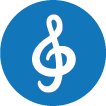 MUSIC
MUSIC -
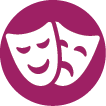 THEATRE
THEATRE -
 VISUAL ARTS
VISUAL ARTS -
 CULTURAL GRPS
CULTURAL GRPS
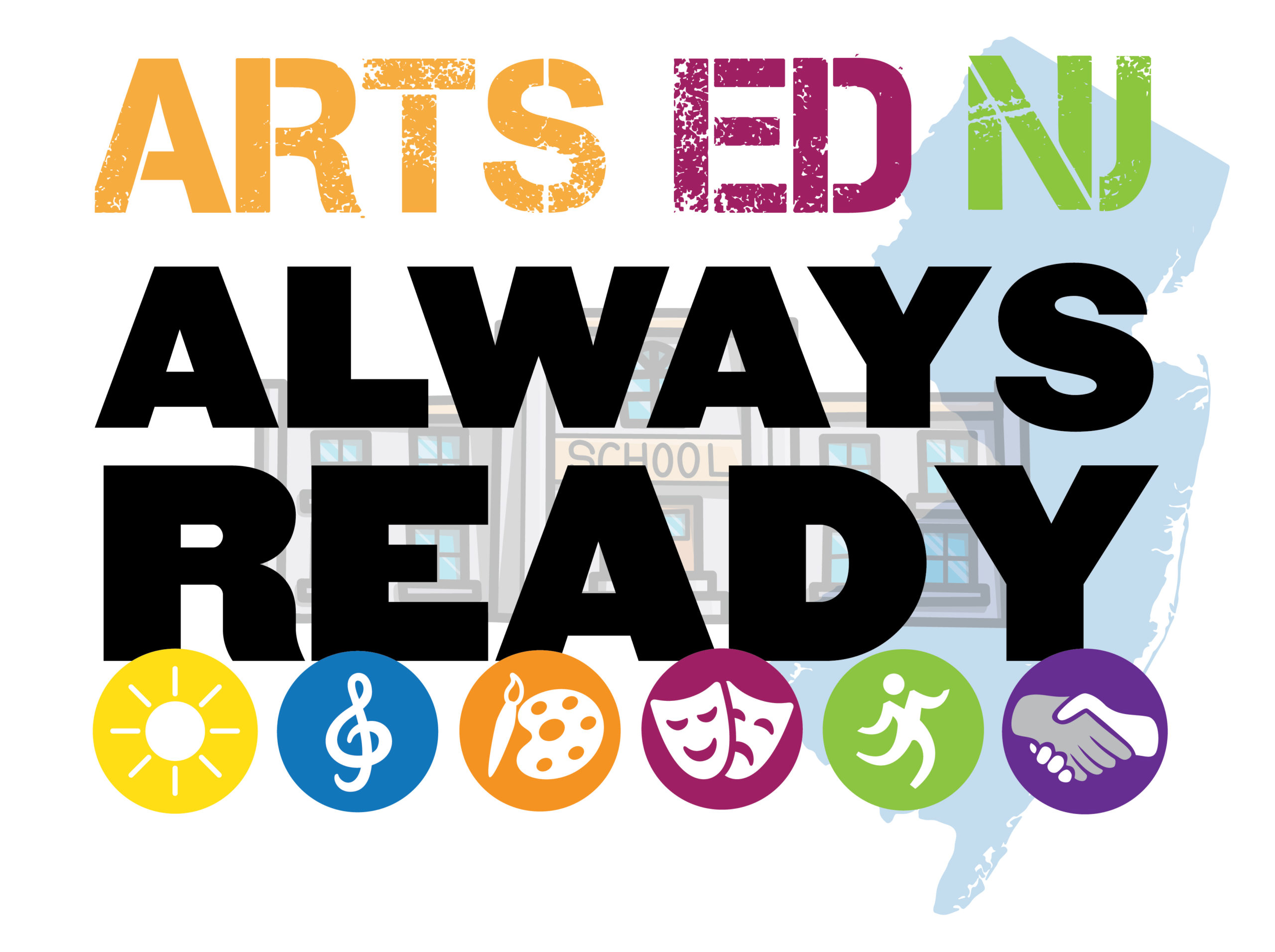
The impact of the pandemic had a deep and lasting effect on young people’s lives as well as their families and teachers. Arts education has always helped students connect to their creativity, sense of identity, and expression of their voice. As we enter a new phase in the COVID pandemic, arts education is more critical than ever. Arts education will help reconnect students to the power of learning. Arts education will provide for the much-needed social emotional learning needs that students have coming back to the school year. We have a unique opportunity to apply all that arts education offers to make a big impact on the next generation of members of this changing and growing society.
It’s time to gather the best that arts education offers to march forward – together!
As of the September 2022 update of this guidance, THERE ARE NO STATE MANDATED COVID MITIGATION REQUIREMENTS and Visual and Performing Arts Programs are returning to pre-COVID pandemic practices. Each district is making individualized determinations in response to CDC and/or New Jersey Department of Health recommendations and the needs of its community.
The guidance on this website was developed to meet the specific needs that emerged during the COVID-19 crisis and remain as an archival reference to be used as necessary.
Foundational Principles for All Circumstances
These are the key principles and best practices that school administrators, educators, and families must ALWAYS have in place.








Guidance Background
In May 2020, Arts Ed NJ convened the September Ready Taskforce for Arts Education. Member organizations include: New Jersey Department of Education, New Jersey State Council on the Arts, New Jersey Education Association, New Jersey Principals and Supervisors Association, New Jersey PTA, New Jersey School Boards Association, New Jersey Art Administrators Association, New Jersey Music Administrators Association, Arts Ed NJ, Art Educators of New Jersey, Dance New Jersey, New Jersey Music Educators Association, New Jersey Thespians, Speech and Theatre Association of New Jersey, Geraldine R. Dodge Foundation, Grunin Foundation, Montclair State University, Rowan University, and Young Audiences of New Jersey and Eastern Pennsylvania.
More than 100 arts administrators, educators, practitioners, and association leaders have joined together to develop the strategies, plans, and solutions needed for arts instruction to be delivered to our students in a way that addresses, first and foremost, the health, safety and well-being considerations for our students, faculty, and staff.
This group continued to meet throughout the Fall ‘20, Winter ‘21, Spring ‘21, Summer ‘21, Fall ’21, and Winter ’22, providing new guidance as the changing conditions and new knowledge dictated.
This document provides practical guidance for K-12 schools as administrators and arts educators seek to provide meaningful arts instruction for students of all ages and grade levels as New Jersey emerges from the COVID-19 pandemic. In this unique time, arts educators are modifying their practices not only in teaching, but in classroom orientation, cleaning, spacing, and management. It’s understood that arts educators, as trained professionals, are committed to offering the very best instruction so all students can learn and grow in their knowledge, understanding, and love of the arts.
By maintaining access to meaningful arts learning, arts educators will continue to support the artistic, academic, social and emotional development of students, schools, and communities across New Jersey.
To that end, some important things to bear in mind about the Always Ready Guidance for Arts Education:
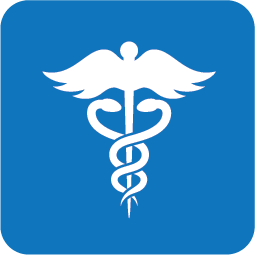
The guide does not purport to replace or contradict the guidelines issued by the Centers for Disease Control (CDC), the State of New Jersey, or local public health departments regarding the timing or protocols for how schools should operate in our new reality of education.
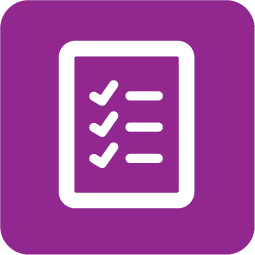
There is no expectation that all schools and districts in New Jersey will or should follow every recommendation included here. As directed by New Jersey’s The Road Forward Restart Health and Safety Guidance for the 2021/2022 School year every district is handling the pandemic recovery process based on their own circumstances.

Reference in this report to any specific commercial product, process, or service, is for information and convenience of the reader and does not constitute an endorsement, by Arts Ed NJ or our affiliated partners.
Compendiums of Previous Guidance
Discipline-Specific Guidances
A Summary Overview of Arts Education Policy in New Jersey
A Constitutional Imperative
On September 19, 2019 Governor Phil Murphy announced that New Jersey had become the first state in the nation to provide universal access to arts instruction for all public-school students. This accomplishment was achieved after decades of sustained work by arts educators, arts organizations, administrators, school board members, parents, and students built on the fundamental belief in the importance of the arts as part of a well-rounded education that must be afforded to all students.
The underpinnings of this achievement are rooted in the New Jersey State Constitution.
Article VIII, Section IV, paragraph 1 states:
“The Legislature shall provide for the maintenance and support of a thorough and efficient system of free public schools for the instruction of all the children in the State between the ages of five and eighteen years.”
In May of 1997, the New Jersey Supreme Court ruled in the case of Abbott v. Burke on the two main parts of the Comprehensive Education Improvement and Financing Act (CEIFA) signed into law in December of 1996 by then Governor Whitman. CEIFA was comprised of two parts: the New Jersey Core Curriculum Content Standards and a school funding formula. Justice Adam B. Handler, writing for the majority, upheld the previously authored New Jersey Core Curriculum Content Standards (now the New Jersey Student Learning Standards), commenting in his decision that they:
“are facially adequate as a reasonable legislative definition of a constitutional thorough and efficient education.” (Source: Abbott v. Burke)
It is this, and subsequent rulings by the New Jersey State Supreme Court that have codified the New Jersey Student Learning Standards, and by extension the content areas that comprise the standards, as the definition of a “thorough and efficient” education as guaranteed by the state constitution.
The 2020 New Jersey Student Learning Standards for the Visual and Performing Arts
On June 3, 2020, the New Jersey State Board of Education adopted the 2020 New Jersey Student Learning Standards for the Visual and Performing Arts (NJSLS) identifies essential core learning in the arts, defined as dance, music, theater, visual art and media arts. The NJSLS states:
All students will have equitable access to a quality, arts education that leads to artistic literacy and fluency in the artistic practices of the five art disciplines as a mechanism for:
- Performing, presenting or producing, as artistically literate individuals, by expressing and realizing creative ideas and implementing essential technical skills and cognitive abilities significant to many aspects of life and work in the 21st century;
- Responding to artistic ideas and work with personal meaning and cognizance of the ability of the arts to address universal themes, including climate change;
- Creating new artistic work reflective of a variety of ethnic, racial, and cultural perspectives; and
- Connecting and evaluating how the arts convey meaning through all arts and non-arts disciplines and contexts of our global society.
The New Jersey Student Learning Standards for Visual and Performing Arts (NJSLS-VPA) describe the expectations for literacy and fluency in five artistic disciplines: dance, music, theatre, visual arts, and media arts. Each artistic discipline has independent skills, knowledge, and content. However, as a field, the arts are interdependent, connected, and inclusive. The NJSLSVPA are designed to guide the delivery of arts education in the classroom with new ways of thinking, learning, and creating. Equitable access to a quality arts education is only achieved when the five arts disciplines are offered continuously throughout the K–12 spectrum.
This means the arts programs must have the same level of academic rigor and educational validity as any other core subject such as language arts literacy or math.
The standards further define learning expectations by grade band. The NJSLS-VPA were created to ensure that all students are able to:
- Communicate with basic literacy in each of the five arts disciplines by the end of grade 5 by using the vocabulary, materials, tools, techniques, and intellectual methods of each arts discipline in a developmentally appropriate manner.
- Beginning in grade 6, student learning in the arts is driven by specialization, with students choosing one of the five arts disciplines based on interest, aptitudes, and career aspirations. By the end of grade 8, students are expected to communicate with competency in their self-selected arts discipline.
- By the end of grade 12, students are expected to communicate with proficiency in one or more arts disciplines of their choice.
By graduation from high school, all students shall, in at least one area of specialization, be able to:
- Respond to works of art with insight and depth of understanding, calling upon informed acquaintance with exemplary works of art from a variety of cultures and historical periods.
- Develop and present basic analyses of works of art from structural, historical, cultural, and aesthetic perspectives, pointing to their impact on contemporary modes of expression.
- Perform/present/produce in a self-selected arts discipline with consistency, artistic nuance, and technical ability, defining and solving artistic problems with insight, reason, and technical proficiency.
- Relate various types of arts knowledge and skills within and across arts disciplines, by mixing and matching competencies and understandings in artmaking, history, culture, and analysis in any arts-related project.
School districts have until September 2022 to update and align local arts education curricula to the new Visual and Performing Arts Standards
High School Graduation Requirements in the Arts
The New Jersey Administrative Code requires that, in order to successfully complete high school, students must meet the state’s Graduation Requirements, including 5 credits (1 year) in Visual & Performing Arts for High School graduation effective with the 2004-2005 ninth grade class (graduating class of 2008).
Social and Emotional Learning and Arts Education
“I believe everyone will soon come to realize that our arts educators are the secret weapon to implementation of Social Emotional Learning in our schools.” – Dr. Maurice Elias
As noted in the New Jersey Department of Education’s Learning Acceleration Guide:
The NJDOE recognizes that addressing student learning and social emotional needs in strategic and constructive ways is essential to both the short-term response to the current pandemic and our long-term commitment to educational equity and excellence.
Social Emotional Learning (SEL) was around before the COVID-19 pandemic and will be around long after; however, the common trauma we are all experiencing has put a magnifying glass on the necessity for schools to help students survive and thrive when confronted with profound challenges. Therefore, the social and emotional well-being of educators, staff, and students must be a central consideration within the reopening plans of schools throughout New Jersey. The singular priority of schools as they seek strategies to navigate the pandemic is student and staff safety–physically, mentally, socially, and emotionally. Our students cannot learn until they feel safe.
SEL is a competency-based approach that can help achieve that safety by building students’ self-awareness, self-management, social-awareness, relationship management, and responsible decision-making skills (simplified to the three goals of SELF, OTHERS, DECISIONS). It is through SEL that students develop the skills to respond to challenges. It is essential that arts educators fully leverage the connections between SEL and the arts. Our students need SEL and arts education now more than ever!
The Collaborative for Academic and Social Emotional Learning (CASEL) has included a useful checklist in An Initial Guide to Leveraging the Power of Social and Emotional Learning As You Prepare to Reopen and Renew Your School Community to assist leaders as they consider the practical ways to operationalize and integrate SEL into transition plans. Arts educators have a unique opportunity to engage students in transformative SEL (anchored in the notion of justice-oriented citizenship, with issues of culture, identity, agency, belonging, and engagement explored as relevant expressions of the five core SEL competencies) a framework that is being developed by CASEL, to advance “SEL as a Lever for Equity”. An equally important resource for arts educators and administrators is the Arts Education and Social and Emotional Learning Framework, which is designed to support two primary goals:
- Empowering arts educators with the information they need to revise curricula and instruction to embed the activation of the SEL components into practice.
- Providing arts educators, administrators, and other decision-makers with the information needed to elevate the understanding of how arts education is a valuable tool to support the implementation of SEL strategies in a school or district.
As arts educators prepare to make instructional choices that will support the social and emotional needs of students, it will be paramount that they invoke the philosophical foundation, common language, essential questions, and enduring understandings articulated throughout the Arts Education and Social and Emotional Learning Framework. SEL is not a box to be checked or another item for educators to squeeze into instructional time with students. When done well, transformative SEL through arts education bears the indicators of great teaching. For SEL to be effective in teaching students the life skills needed to navigate their world after they leave the arts classroom, it must be embedded into curricular content as embodied by dance, music, theatre and visual art.
Compelling rationale for arts education utilizing SEL are:
- Purposeful integration of SEL into arts education will enrich the students’ personal connection to the arts.
- The relationship built between arts teachers and students over multiple years of instruction fosters the caring environment necessary to help build school connectedness and foster empathy.
- The perseverance needed to dedicate oneself to artistic excellence fosters resiliency both in and out of the arts classroom.
- Artistic creation fosters self-awareness and allows students to develop a greater sense of autonomy and emotional vocabulary.
- The collaborative community developed in the arts classroom welcomes discussions and an awareness of acceptance and embracing diversity.
- Through the arts students learn the necessity of personal goal-setting, self-assessment, and accountability as they develop high standards for their artist endeavors and themselves.
- Arts education provides developmental experiences that actively allow students to practice and hone social emotional competencies.
The NJDOE understands the important role of climate and culture, more specifically, social and emotional learning (SEL) and how critical it is in re-engaging students, supporting adults, rebuilding relationships, and creating a foundation for academic learning.
For additional tool and resources visit the Center for Social Emotional Learning and Arts Education at: ArtsEdSEL.org
Information from this section has been derived from the Arts Education & Social and Emotional Framework (Arts Ed NJ), Advocating for Music Education Utilizing Social Emotional Learning (Scott Edgar, Bob Morrison) and the Collaborative for Academic and Social Emotional Learning (CASEL).
Statement of Principles
In September of 2017, New Jersey’s leading education associations came together to endorse a statement of principles regarding the importance and value of arts education. The eight principles are:
First, every student in New Jersey should have a comprehensive education in the arts.
Second, to ensure a basic education in the arts for all students, the arts should remain recognized as serious, core academic subjects.
Third, as education policy makers develop decisions, they should incorporate the multiple lessons of recent research concerning the value and positive impact of arts education.
Fourth, qualified arts teachers and sequential curriculum must be recognized as the basis and core for substantive arts education for all students.
Fifth, arts education programs grounded in rigorous instruction, provide meaningful assessment of academic progress and performance, and take their place within a structure of direct accountability to school officials, parents, and the community.
Sixth, community arts providers that offer exposure to, and enrichment through the arts in both in-school and out-of-school settings give valuable support and enhancement to an in-school arts education.
Seventh, integrating the arts into other curricular areas, when done properly, enlivens learning for our students. Arts integration should be coordinated between the arts educators and the other content specialists and/or community partners to ensure learning outcomes in all content areas are met. However, arts integration, while a valuable tool for learning, is not a substitute for the acquisition of skills and knowledge provided by in-school arts education programs.
Eighth and finally, we offer our unified support to those programs, policies, and practitioners that reflect these principles.
This document was signed by New Jersey Association of School Administrators, New Jersey Education Association, New Jersey Principals and Supervisors Association, New Jersey PTA, New Jersey School Boards Association, and Arts Ed NJ.
Do you have additional info to share? Help us enhance and keep this resource relevant here:
As of the September 2022 update of this guidance, THERE ARE NO STATE MANDATED COVID MITIGATION REQUIREMENTS and Visual and Performing Arts Programs are returning to pre-COVID pandemic practices. Each district is making individualized determinations in response to CDC and/or New Jersey Department of Health recommendations and the needs of its community.

Current Health and Safety Guidance for Arts Education
As of the September 2022 update of this guidance, THERE ARE NO STATE MANDATED COVID MITIGATION REQUIREMENTS and Visual and Performing Arts Programs are returning to pre-COVID pandemic practices. Each district is making individualized determinations in response to CDC and/or New Jersey Department of Health recommendations and the needs of its community.
This archival Arts Ed NJ Guidance was originally developed based on the policies, guidance, research and recommendations available. As conditions change this guidance will be updated to reflect current state executive orders and agency recommendations.
In districts that choose to keep mitigation strategies such as masks in place, we encourage schools to use the corresponding mitigation strategies outlined below
Regardless of local conditions, proper hygiene and ventilation strategies should be a priority for all schools at all times.
FOR ONLY THOSE SCHOOLS WHERE MASKS ARE REQUIRED
Outdoors
Outdoors (All ages): There are no mask, distancing, or time limitations for any outdoor visual and performing arts activity. Outdoors remain the safest space. No mitigations are needed (subject to level of local transmission rates). Proper hygiene strategies should remain in place.
In Schools
Please note: in schools where mitigation strategies have been lifted, there are no longer any recommended mitigation strategies for the visual and performing arts.
The following applies to indoor visual performing arts classrooms and activities in districts where mitigation strategies are still in force (Dance, Media Arts, Music, Theatre, Visual Art):
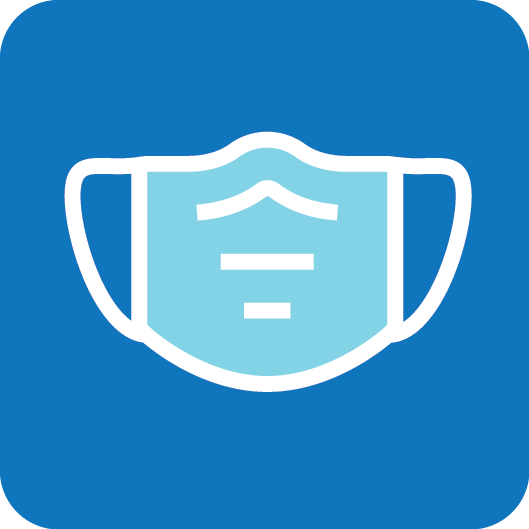
Masks: Masks (made of appropriate material*) should be utilized by all performers except wind players where the instrument itself should be masked. Wind Players may have a normal mask around the neck when playing the instrument which should be used to cover the mouth when not playing. Specially designed player masks are not necessary.
NOTE: Flutes and Recorders do not need any covering as they do not generate aerosols.
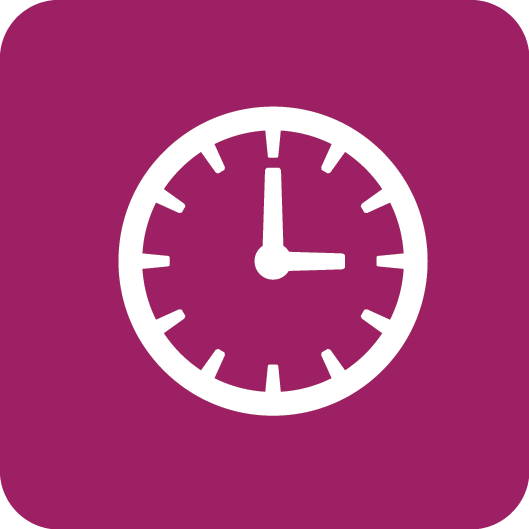
Timing: In spaces with good ventilation, indoor rehearsal time should be limited to 50 minutes** followed by one air exchange before resuming (A minimum of 3 air changes per hour should be used or 1 air change every 20 minutes). If there are spaces with higher air change rates, you may consider longer rehearsal times.
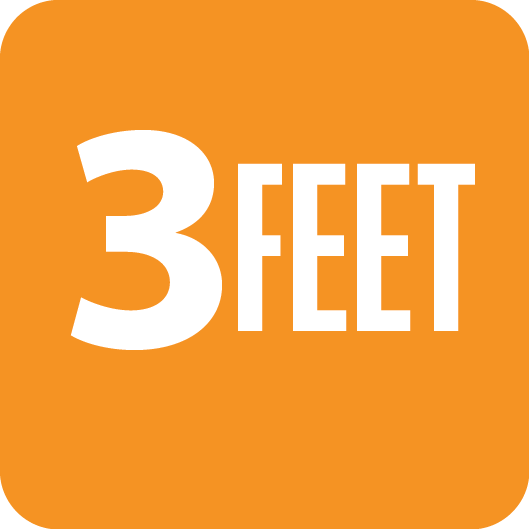
Physical Distancing: Distancing of three feet (measured center of seat to center of seat) is suggested when feasible but should not preclude an activity from taking place. A properly ventilated space should be used. Proper hygiene strategies should remain in place.
Proper hygiene and ventilation strategies should be a priority at all times.
*Material should consist of MERV13 material or ASTM F2100 (or similar) standard.
** For classes over 50 minutes start and end the class with a non-performance activity
NOTE: Mitigation strategies for timing and social distancing should be implemented “when feasible” and should not be used as an excuse to preclude any activity from taking place.
Note on Face Shields and Partitions: Plastic face shields do not stop aerosol, masks do; room dividers inhibit the function of the HVAC system and are not recommended.
Indoor Performances
Currently there are no prohibitions on indoor performances for schools. Follow all applicable district requirements for indoor performances.
Audience Considerations
Audience Mitigation: There are no statewide audience mitigation guidelines. Local school districts may impose their own restrictions.
Audience Size: There are currently no audience limitations in effect in New Jersey. Local school districts may impose their own restrictions for physical distancing.
Physical (Social) Distancing: There are no statewide audience mitigation guidelines. Local school districts may impose their own restrictions.
Vaccination Status: Most New Jersey Performing Arts Venues currently require proof of vaccination to attend indoor performances. This does NOT apply to scholastic performances.
Health Screening: There are no statewide health screening guidelines. Local school districts may impose their own restrictions
If an audience member is unwell, they should stay home.
Performer/Performance Considerations:
In communities where masks are still required:
Masks: Masks should be worn at all times by all staff, volunteers and crew. Performers should wear a mask at all times with the following exceptions:
- Wind Instrumentalists: Wind players may remove their mask while performing. Once a performance has concluded the mask should be returned to cover the face.
- Wind Instruments: Wind instruments should be masked with bell covers at all times.
- Vocal Performers: Masks should be worn at all times by vocal performers. Microphones should be used where feasible.
- Actors/Theatrical Performers: Masks should be worn at all times by actors and theatrical performers. Microphones should be used where feasible.
- Dancers: Masks should be worn at all times unless the dancer is “engaged in high-intensity aerobic or anaerobic activity”. In this instance the mask may be removed for performance and should be returned once a performance segment concludes.
Physical (Social) Distancing: There are no statewide audience mitigation guidelines. Local school districts may impose their own restrictions.
Health Screening: All performers, faculty, and staff should conduct a health screening prior to arriving at the school performance using the CDC Symptoms Self-Checking Tool: https://www.cdc.gov/coronavirus/2019-ncov/symptoms-testing/symptoms.html#
If a performer/faculty/staff member is unwell, they should stay home.
Hygiene: Proper hygiene strategies for audience members and performers should be followed at all times.
Equipment: Avoid shared equipment where the mouth may come into contact with equipment (such as mouthpieces, microphones, etc.) and follow manufacturer’s instructions to clean thoroughly between uses. Consider disposable microphone covers. Use proper cleaning strategies to wipe down dressing rooms, microphones (if used), props, set pieces, instruments, costumes, wigs.
Resources for Indoor Performances:
Centers for Disease Control and Prevention (CDC)
https://www.cdc.gov/coronavirus/2019-ncov/community/schools-childcare/k-12-guidance.html
New Jersey Department of Health COVID-19 Information for Schools
https://www.state.nj.us/health/cd/topics/covid2019_schools.shtml
International Coalition of Performing Arts Coalition Aerosol Study
https://www.nfhs.org/articles/unprecedented-international-coalition-led-by-performing-arts-organizations-to-commission-covid-19-study/
Arts Ed NJ March Forward Fall 2021 Guidance for Arts Education
https://marchforwardnj.org/
Mitigation Recommendations are based on:
Coalition of Performing Arts Aerosol Study (Feb 2022 Update): Dr. Shelly Miller, University of Colorado Boulder and Dr. Jelena Srebric, University of Maryland, Lead Researchers https://www.nfhs.org/articles/unprecedented-international-coalition-led-by-performing-arts-organizations-to-commission-covid-19-study/
Current CDC Guidance (https://www.cdc.gov/coronavirus/2019-ncov/science/community-levels.html)
United States Department of Education Return to School Roadmap
New Jersey Department of Health and New Jersey Department of Education:
The Road Forward Health and Safety Guidance for the 2021-2022 School Year https://www.nj.gov/education/roadforward/docs/HealthAndSafetyGuidanceSY2122.pdf
New Jersey Department of Education: The Road Forward, Engage, Recover, and Reimagine Education in New Jersey https://www.nj.gov/education/roadforward/
For more detailed information on this and other visual and performing arts guidance, please visit https://www.artsednj.org/september-forward/
Do you have additional info to share? Help us enhance and keep this resource relevant here:

As of the September 2022 update of this guidance, THERE ARE NO STATE MANDATED COVID MITIGATION REQUIREMENTS and Visual and Performing Arts Programs are returning to pre-COVID pandemic practices. Each district is making individualized determinations in response to CDC and/or New Jersey Department of Health recommendations and the needs of its community.
Dance Education Considerations for School Reopening 2021-2022
As part of the blueprint to return to the school environment, a dance classroom led by a certified PreK-12 dance educator is a space that will empower all students to engage, refresh, and develop social, emotional, intellectual, expressive, and creative thinking skills. Certified dance educators are prepared to return to a fully functioning dance classroom in order to enable a versatile and empowering dance curriculum to support students’ mental, physical and emotional needs provoked by the pandemic. It is essential to preserve access to and funding for dance classes and dance programs within the daily schedule of PreK-12 settings, as well as an increase in offering, in order to nurture a positive learning environment where students are given the opportunity to express, move, create and connect to the self and the community. Dance education can help build self-esteem and a positive body image; promote responsibility; navigate self-discovery; develop self-management skills; teach and engage collaboration; bolster creative thinking; strengthen decision making; encourage risk taking; and praise diversity. A well-rounded dance curriculum that spans the grade levels of PreK-12 facilitated by certified dance educators provides students the means to become self advocates, creative thinkers, and leaders.
The Value of Technology in the Classroom
There were many discoveries the virtual learning environment unveiled as positive extensions for the in-person dance classroom that heightened the quality and experience of the dance education curriculum. Virtual platforms that enable video submission, video sharing, and online student feedback extend the walls of the dance classroom beyond the dedicated class time. Virtual classroom platforms allow assignments, archives of class learning experiences, and visual lesson supports to be readily available and accessible for all learners. Funding and continued efforts for equity in technology access is highly encouraged to create tech-savvy dance classrooms in order to continue to enhance the impact of dance learning and increase the accessibility to all learners.
Considerations for Transitioning Back to the Dance Classroom
Beyond building upon pre-existing knowledge of seasonal learning disruptions as a guide, consider the following factors as likely influencers on students and school communities while transitioning back into the dance classroom. (Returning to the Classroom After COVID-19 Shutdowns: What to Expect and How to Be Prepared)

Trauma: For some students, sudden school closures occurred alongside other potentially traumatic events, including family income and job losses, health crises, and a high overall level of disruption.

Loss of enrichment opportunities: Students following stay-at-home directives are unable to access enrichment opportunities such as field trips and face-to-face tutoring sessions.

Reduced access to educational resources: For families focused on survival during the shutdown period, concerns about housing, food, healthcare, and jobs may take priority over student learning.
As the state dance organization and state affiliate for the National Dance Education Organization, Dance New Jersey advocates for the inclusion of dance in all New Jersey public and private PreK-12 schools and supports dance educators across multiple environments (i.e. studios, colleges/universities, community centers, etc.) with professional development and networking. For more information on the impact of dance education visit www.ndeo.org/evidence to review the following documents: “Stand Up for Dance in America’s K-12 Schools” brochure and Evidence: A Report on the Impact of Dance in the K-12 Setting.
To connect to continued advocacy efforts for Arts Education, go to Arts Are Education
School Reopening 2021-2022 vs. 2020-2021 Guidance
Focused on returning to the dance classroom, guidance for school reopening 2021-2022 includes the following additional information.
- Facilities update based on CDC and NJDOH
- Tech savvy dance classroom examples
- Information about returning to more intense levels of physical activity
- Performance guidance
- New technology platforms to extend and support the impact of the dance classroom
For guidance for remote learning, refer to September Ready Guidelines for School Reopening 2020-2021.
Scheduling, Facilities, & Social Distancing Recommendations
Facilities
The dance classroom may return to a fully functioning movement and creative environment with the maximum number of students permitted in the space and without restriction as per local and NJDOE guidance. Due to continued updating on state and federal levels, it is recommended to check the current guidelines from the CDC, state, and local agencies for mask requirements and social distancing.
The following recommendations address the dance classroom with implementation of social distancing and mask mandates to support continuity of the dance curriculum and viability of dance programs.
- When feasible, tape the floor into 3×3 to 6×6 personal squares with a clear ‘path’ from the doorway to each square. The CDC recommends that all students, regardless of age, maintain a distance of at least 6 feet when increased exhalation occurs, including exercise and sports. Yet, the social distancing requirement should not hinder the offering of and participation in Dance. Review the current social distancing CDC guidelines for up-to-date appropriate measures for social distancing.
- Designate specific procedures within the classroom to assign how students move to their spot and enter and exit the classroom while socially distanced. Maintaining procedures and records, including assigned spots on the barre or in the center floor, are useful for contact tracing procedures.
- Add markings on the floor, possibly around the perimeter of the room, for student belongings, books, shoes, etc.
- Remove unnecessary items, such as furniture, area rugs, mirror coverings, and theatre fabrics (curtains, legs, etc.), from studios and other shared spaces.
- Keep each student’s belongings in an assigned, separate, safe and clean space such as individually labeled cubbies, lockers, or areas.
- When feasible, mark spots at the ballet barres to adhere to social distancing guidelines in all directions.
- Use free-standing barres when possible, or tape off 3 feet to 6 feet of distance on installed barres in the studio/theater.
- If necessary, due to scheduling and physical space limitations, develop a clear schedule that allows some dancers to engage in self-paced, stationary, socially distanced learning activities around the perimeter or in one section of the room while others are dancing in their designated spaces.
- Larger spaces may be provided for larger groups. Consider the auditorium, gymnasium, cafeteria, outdoor space and adapt movement activities to suit the environmental needs and ensure safety of all students.
- The dance studio space should not be used for other purposes throughout the school day in order to protect the cleanliness of the space, for the safety of the students, and to be able to provide rigorous, standards-based dance instruction.
- Windows and doors should remain open when possible in order to provide ventilation. The A/C should be on if available. Consider installing HEPA air filters and purifiers to maintain safe air flow, especially in studios with air conditioning. Refer to CDC Ventilation in Buildings: https://www.cdc.gov/coronavirus/2019-ncov/community/ventilation.html#daf
- Frequently used equipment must be sanitized after each use. Equipment includes, but not limited to, barres, dance floor, sound systems, mats, media/live-stream equipment, chairs, tables, props, musical instruments, microphones, cubbies/lockers, etc.
- Suggested CDC floor cleaners approved to kill COVID-19 include the following:
- Harlequin approved disinfectant (Marley) (EPA# 10324-167)
- Stage Step: ProClean D Plus (Marley) (EPA#1839-95)
- BONA: STA Disinfecting Cleaner (Wood) (EPA# 91861-2)
- Suggested CDC floor cleaners approved to kill COVID-19 include the following:
Classroom Setup: Tech Savvy Suggested Hardware
The following list of hardware was compiled from suggestions of dance educators who have worked in in-person/hybrid settings. It is recommended to continue to implement a tech-savvy dance classroom due to the increased accessibility of learning and impact of the dance curriculum.
N Visual
- Additional screen: one as the teaching source and the other to monitor student view
- Camera (video and/or still): for class work documentation, performances, promotional recording and stills, assessment, creation of video libraries, etc.
- Tripod
- Document camera: a modernized overhead projector that enhances lesson delivery and virtual learning
- Projector and screen or mounted TV screen: enables to see virtual students on a large screen, as well as show digital presentations
- Webcam: an additional webcam to the one included in your computer allows better quality visuals for your students.
- Wide angle lens: clip-on wide angle lenses change the narrow view of an iPhone, iPad, smartphone or laptop camera into a wide view
O Audio
- Headset
- Portable Speaker
- Wireless Headphones
~ Connectivity
- Ethernet adapter
- HDMI cords
- HDMI switcher: allows you to connect two different HDMI-compatible devices or consoles to the same port on the TV or monitor
- Splitter docking station: docking stations include some combination of extra USB ports, audio jacks, an Ethernet jack, SD card slots, and one or more display ports (HDMI, DisplayPort, VGA, DVI, etc.). Allows for splitting the computer display onto multiple screens.
- External hard drive
Examples of Classroom Setup with technology and social distancing
The images provided are samples to serve as a catalyst for ideas to arrange technology for a tech-savvy dance classroom and to manage classroom organization in the event of social distancing requirements.
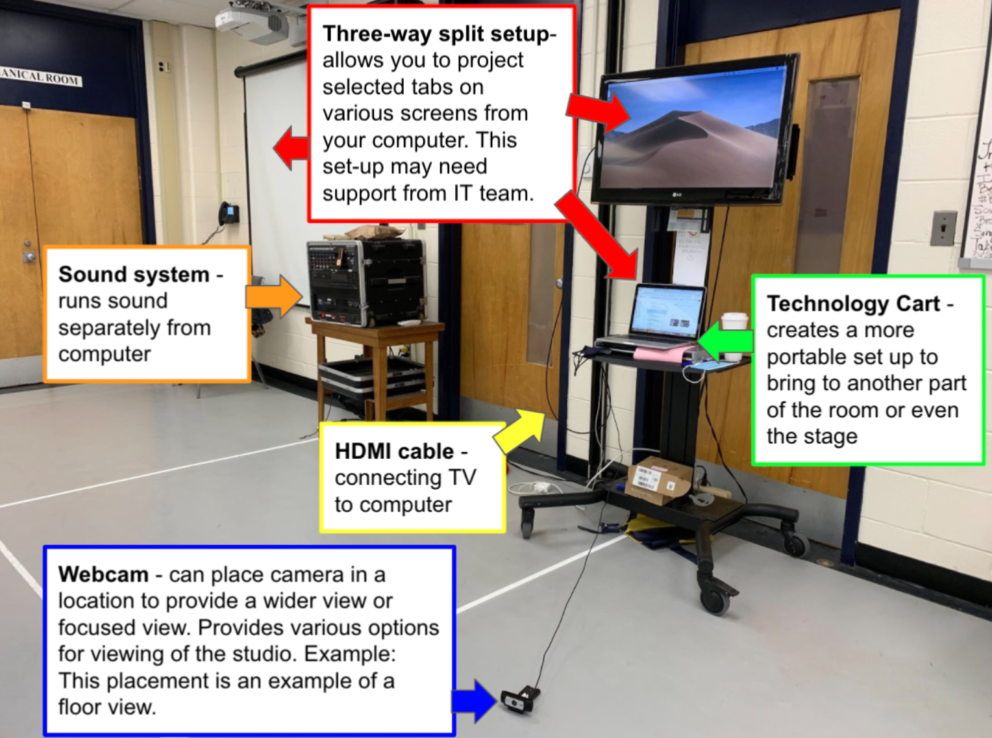
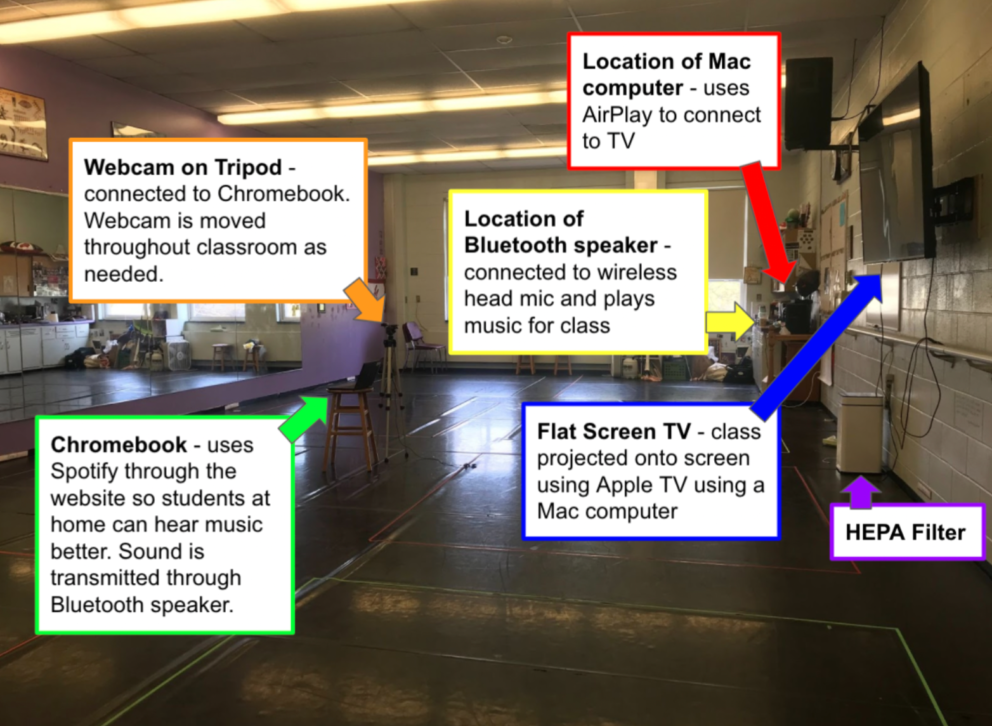
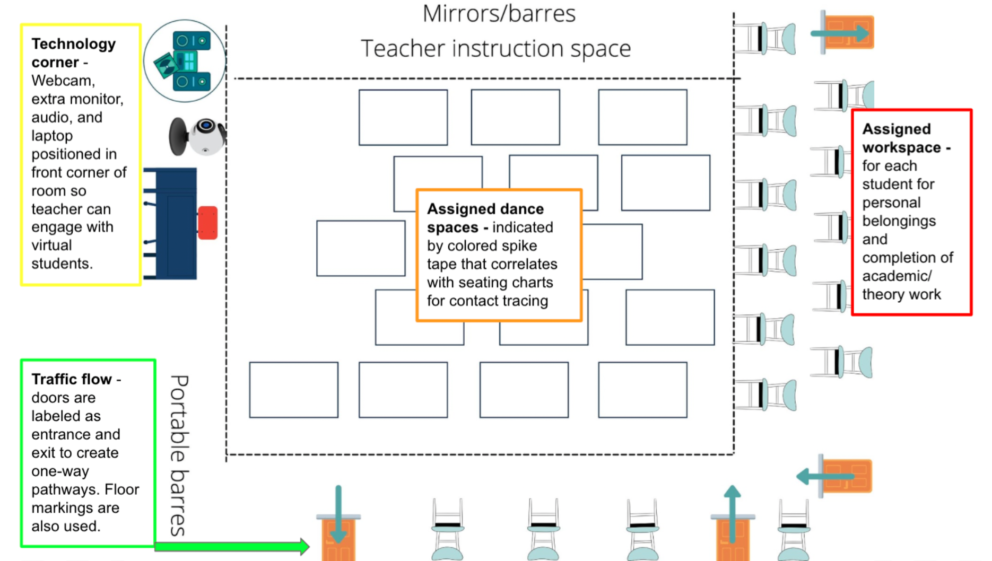
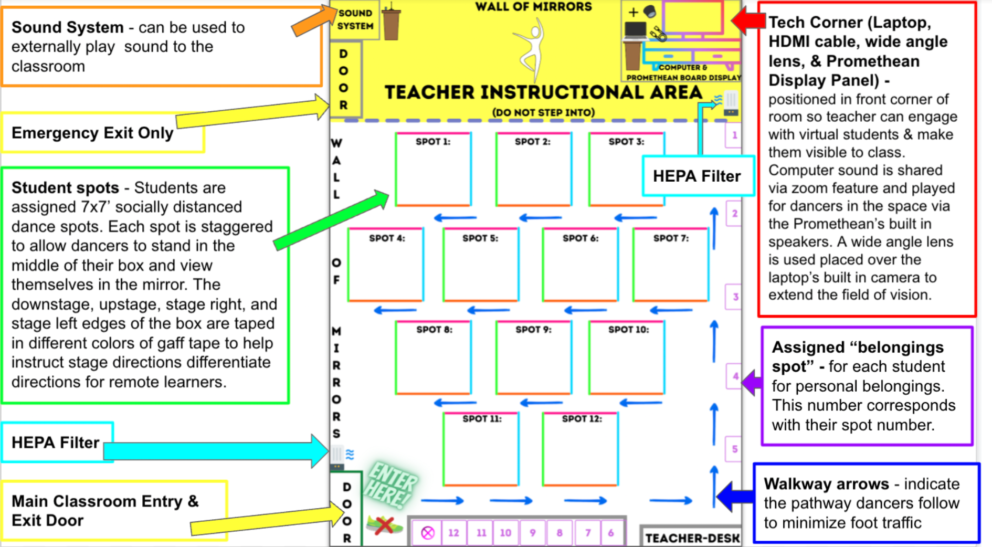
Dress Code
In the event of fully functioning dance classrooms, dress code requirements may return to normal as indicated by dance educators.
Recommendations below are provided in the event of alternate scenarios such as social distancing and mask mandates.
- Educators should advise and adapt program/class dress code policies to new learning scenarios.
- If students are not changing for class, consider encouraging students to wear clothing that allows for full movement and is safe for participation.
- If applicable, educators are encouraged to create a procedure for locker or changing rooms to accommodate social distancing guidelines. Sourced from the New Jersey State Interscholastic Athletic Association:
- Locker room use is limited to changing, storage, hand washing, and restroom use only.
- Minimize the amount of time spent in the locker room.
- Social distancing and face coverings are recommended for all staff and students while inside the locker room unless it would inhibit the individual’s health.
- All areas must be cleaned and sanitized in accordance with CDC and EPA guidelines.
- Schools must ensure indoor facilities have adequate ventilation, must prepare, and maintain hand sanitizing stations, and must ensure that students wash hands frequently.
- Follow CDC, state, and district guidelines for wearing masks.
- As the mask may become sweaty in dance class, provide or advise students to have a second mask to wear after dance. Dance/USA COVID-19 FAQ for dancers and dance companies returning to the studios has considerations for dancers wearing masks.
- Determine appropriate masks for dance/physical activity. The most effective fabrics for cloth masks are tightly woven such as cotton and cotton blends, breathable, and in two or three fabric layers. Masks with exhalation valves or vents, those that use loosely woven fabrics, and ones that do not fit properly are not recommended.
- Masks should be washed after every use and/or before being used again, or if visibly soiled or damp/wet.
- Disposable face masks should be changed daily or when visibly soiled, damp or damaged.
- Students and schools should have additional disposable or cloth masks available for students, teachers, and staff in case a back-up mask is needed (e.g. mask is soiled or lost during the day).
- Consult with school nurses and medical professionals about students with specific respiratory conditions (e.g. asthma).
- No street shoes or outside shoes allowed on the dance floor under any circumstance.
- Genre/style specific footwear should be worn and is dependent on the class being taught.
- Students are encouraged to bring their own water bottle. Water bottles must not be shared. Hydration stations should not be utilized.
Section Resources
CDC guidelines – Operational Strategy for K-12 Schools through Phased Prevention
CDC guidelines – Ventilation in Buildings
Dance USA: Return to Dancing and Training Considerations Due to-COVID-19
New Jersey State Interscholastic Athletic Association Covid-19 Spring Guidelines
Dance/USA COVID-19 FAQ for dancers and dance companies returning to the studios
Instructional Strategies
Recommendations and resources are provided for best practices in lesson planning and delivery for transitioning back into the dance classroom with consideration for student needs and populations.
In-Person Learning
l Level of Dance Activity
Sourced from AGMA & SDC Return to Stage and Performing Arts Playbook
In order to best support dancers, any reopening plan should be designed to allow the dancers to get back into the studios incrementally, build on the limited and virtual class and conditioning activities they have been doing at home, and provide adequate time (up to six weeks) prior to return to be “performance ready.” The following are general principles for reconditioning following injury or a break from training:
- Start at a fraction of the full workload (e.g., 50%)
- Build up gradually (i.e., do not increase volume or intensity of activity by more than 10-20% per week).
- Modify activity level and pace of increase based on symptoms (i.e., increase at a slower pace if there is evidence of injury, excessive fatigue, or physical or mental breakdown).
- Restore general fitness before attempting ballet-specific or sport-specific activities.
- Space out workouts and maintain variety as much as possible (i.e., do not concentrate too much of the same activity within a short timeframe and try to space out “like” forms of exercise [e.g., legs, core, aerobic, high intensity, plyometrics] throughout the week).
l In the event of mask mandates:
- Intensity of class should be monitored and adjusted as dancers get used to wearing masks. Avoid exercises with large, dynamic movements. Body will adapt to wearing masks after a few weeks. Dance USA COVID FAQ – MAY 2020
- Educators should use a microphone and speaker when delivering instruction to students. The use of face coverings and the need for students to spread out to accommodate physical distancing may make it more difficult for educator instructions to be heard. https://www.shapeamerica.org//advocacy/K-12_School_Re-entry_Considerations.aspx
l In the event of social distancing mandates and/or local transmission data:
- Limit activities in lessons that involve physical touch.
- Educators will not provide tactile touch or feedback.
- Center Work: In the event of social distancing mandate, dancers should be able to maintain a minimum of 6 feet distance. Normal breathing should be encouraged rather than cued inhaling and exhaling.
- Across the Floor: Traveling across the floor side by side while maintaining 6 feet distance is recommended. One group should complete the exercise across the entire room before the next group begins.
Hybrid Learning
Educators will plan according to the adapted schedule allowing for the best use of in-person time and remote time. This will require educators to utilize and adapt their curriculum according to best practices in terms of both health and safety, and curriculum and instruction. (Blended Learning Universe)
l To balance the blend of in-person learning and remote learning, the educator may design learning experiences that are engaging and equitable.
(5 Keys to Success in Hybrid Learning)
- Consider the use of asynchronous work as a way for students to explore their own creativity away from the screen
- Consider various modalities for them to present/document their learning.
- To utilize in-person instruction, educators may use virtual learning to develop and teach basic phrase-work for class (e.g. a warmup involving body isolations) so that when in class, students can focus on technical aspects and not sequence.
- The educator may record lessons in the studio teaching technique and choreography for the students to work on at home. The educator can utilize this method for differentiated instruction as well, in particular with students who may need additional technique feedback or are ready for more challenging technical material.
l Windows and doors should remain open if possible to provide ventilation.
Instructional Resources
For resources to support the listed topics, reference Expanded Instructional Strategies.
- Social Emotional Learning (SEL)
- Considerations for Students with Disabilities
- Considerations for Emerging Bilinguals (EBs)
- Considerations for Culturally Relevant Pedagogy
- Considerations for LGBTQ+ Community
- Considerations for Collaborations
Summer Programming
To support the transition back into the dance classroom for student and program benefit, building a summer program may help in easing the students’ and educators’ physical, mental and emotional well-being as the new school year approaches. Below are themes and ideas for summer dance programs.
- Dance and conditioning
- Somatic Practices
- Creative Movement
- Improvisation and Choreography
- Celebrating the Individual through Dance
- Building community through Dance
- Exploring movement through games
- Specific movement practices
Performances
In order to meet the “Performing” state standards (NJ Student Learning Standards: Visual and Performing Arts; National Core Arts Standards), performances are an essential experience for students to share their artistry and skill. Performances may resume as appropriately according to current state and federal guidance from the CDC, state, and local agencies.
l Detailed guidance for production of performances:
- Refer to Reopening Dance in NYC for overall guidance. https://reopening.dance.nyc/
- Refer to the AGMA/SDC guidelines for choreography, production, and space calculations guidance. https://sdcweb.org/return-to-stage-and-performing-arts-playbook/
- Refer to the Actor’s Equity Association’s guidelines for outdoor and indoor performances. https://www.actorsequity.org/resources/Producers/covid19-info/
l When planning for performances, consider the following when social distancing and mask mandates are in place.
- Cast small groups and double cast if possible.
- Keep in-person rehearsal periods shorter than usual.
- Individuals should wear masks during dance activity of any kind—performances (inclusive of any group activity with an audience like fully produced shows, informal shows, open rehearsals, practice sessions, dance battles, dance jams, etc.) classes, and rehearsals. When wearing masks interferes with necessary aspects such as hair, makeup, or wardrobe, performers may temporarily remove masks and should don them as soon as possible. (Reopening Dance in NYC)
- It is recommended to allocate 150 square feet per dancer for movement and exertion. (AGMA/SDC guidelines)
- Choreography should limit partnering and physical touch, or exclude if covid transmission is high in the local area.
- Collaborative performances and opportunities are possible with virtual performances.
- Opportunities to continue guest artist and guest choreographer enrichment experiences can result in performances.
- Outdoor, site-specific performances can be filmed in advance.
Assessment
When schools reopen for in-person instruction, students will return with very different levels of knowledge and skills, with disadvantaged students most likely to exhibit the greatest learning losses. The key to learning recovery in this context is the alignment of instruction and additional supports to where students are in their learning trajectory. Learning assessment – the process of gathering and evaluating information on what students know, understand, and can do – is an essential ingredient in this process of evaluating the state of a student’s learning and in supporting learning recovery and advancement towards learning goals. As such, learning assessment should be a key element of any policy package supporting school reopening, as it puts the focus back on learning. (Learning in the time of COVID-19: the role of learning assessment in reopening schools)
For further recommendations for Formative and Summative Assessment, reference Expanded Instructional Strategies.
Section Resources
AGMA & SDC Return to Stage and Performing Arts Playbook
Dance USA COVID FAQ – MAY 2020
https://www.shapeamerica.org//advocacy/K-12_School_Re-entry_Considerations.aspx
5 Keys to Success in Hybrid Learning
Priorities for Trauma Informed Distance Learning
CASEL Leveraging SEL as You Prepare To Reopen and Renew
Actor’s Equity Association’s guidelines
Learning in the time of COVID-19: the role of learning assessment in reopening schools
Embedded Formative Assessment Second Edition
Yale Poorvu Center for Teaching and Learning: Creating and Using Rubrics
Equipment, Materials, & Supplies
Attention to equipment, materials, and supplies in the dance classroom is required to adhere to CDC, state, and district safety guidelines. The following are considerations for safe handling to mitigate any possible spread.
In-Person Learning
l It is recommended that schools are equipped with the following cleaning supplies:
- Disposable gloves for cleaning equipment based on the CDC recommendation when cleaning and disinfecting.
- Sanitizers, wipes, and paper towels that are easily accessible for staff and students.
- Dance floor cleaner/disinfectant. CDC floor cleaners approved to kill COVID-19 include the following:
- Harlequin approved disinfectant (Marley) (EPA# 10324-167)
- Stage Step: ProClean D Plus (Marley) (EPA#1839-95)
- BONA: STA Disinfecting Cleaner (Wood) (EPA# 91861-2)
- Electronic screen cleaners
l In the event of social distancing mandates:
- Visual signage and verbal reminders for social distancing and masks.
- Floor markings to outline the recommended distance for people to occupy.
- Spike tape, gaff tape or painters tape work well when creating floor markings.
- Designated and labeled places to store any belongings/water bottles.
l Teachers should use voice amplification technology and/or microphones to reduce vocal effort (less droplet spread).
l Students with disabilities should be supplied with their own tactile aides. (ex. manipulatives and floor spots)
l Elementary students should be supplied with their own tactile aides to avoid sharing.
- Tactile aides should be made of materials that are easily cleaned/disinfected and should be disinfected before and after each use.
- If tactile aides are made from fabric such as scarves, options to launder/disinfect these need to be provided as well.
l Staff should be properly trained on how to safely apply disinfectant and have access to the appropriate personal protective equipment needed.
Ensure sufficient ventilation when applying disinfectants. Follow the directions listed on the disinfectant label. Make sure disinfectants are stored appropriately and out of reach of students. Always consult with the school-wide COVID-19 response team before creating a plan for sanitizing equipment.
Hybrid Learning
l Create a safe movement environment at home for both teacher and students.
- Designate a dedicated dance space with safe flooring (e.g. Wood, thin carpet).
- Encourage warm room temperature to avoid injury.
- Provide students with dress guidelines for both in-person and remote learning.
- If applicable, identify barre substitutes at home (e.g. heavy chair, countertop, solid table at appropriate height).
- Encourage students to use a sheet, blanket, drapes, or large material as a decorative background
l Provide students with two sets of any tactile aides if used, one set to remain at home and one set to remain at school to diminish transport of potential virus particles.
l Students need to have access to or be provided with appropriate technology equipment (device with a camera and internet access) and software to complete assignments.
l To support a tech savvy dance classroom, the educator will need a reliable camera and backup camera provided by the school district. This will allow the students in the classroom and at home to have a clear picture of the teacher and to follow the lesson being taught.
l Parental consent forms should be completed allowing for use of video software.
Section Resources
Technology Considerations
Technology has proven to be an impactful teaching tool within the dance classroom becoming a key part of instructional practices. Below are technology learning platforms and best practices for in-school and hybrid learning environments.
Technology Access Considerations
l By the beginning of the school year, all students should have the device and connectivity they need to access continued learning online, particularly among low-income and rural students. (A-BluePrint For Back To School, AEI)
l Schools need to have devices and mobile hotspots for students to take home in the event of remote learning. Schools also need to consider ways of providing technical support in remote learning contexts, including providing on-demand support for educators.
l All apps and technology platforms should be approved by district technology coordinators (for security, compatibility with student devices, etc.) before usage. Additionally, schools should devise a protocol for students to ask for and receive replacements for either their devices or device accessories in case of malfunction of either.
Technology Security and Privacy Considerations

Educators must have parent/guardian consent for sharing of images/video (live and recorded), and alternative options should be available for students who do not give consent.

Review district policy on students’ permissions for viewing (and sharing or not sharing) of educator-generated intellectual property (choreography, instruction, etc.).

Review mandated reporter protocols for the digital age (procedures for witnessing/reporting potential instances of abuse or neglect via live or recorded video).
Technology Platforms
The platforms suggested below are an additional list to the initial 24 platforms highlighted in the Guidelines Document of 2020. Reference September Ready Fall 2020 page 35, for more.
To view the full list of technology platforms, reference Expanded Technology Considerations.
Section Resources
Professional Development
To support educators in navigating in-person learning along with SEL and trauma-informed teaching, professional development workshops in their discipline are important factors in supporting their students and expanding their classrooms. Below are recommendations for professional development for dance educators. Reference September Ready Fall 2020 page 37, for more.
Recommendations

Join the National Dance Education Organization and Dance New Jersey to connect and network with other state and national dance educators and resources through professional development workshops, forums, and research.

Set aside time for staff community building and Professional Learning Communities (PLC) to reconnect, process their emotions and experiences, reflect on what they have learned and how they are applying social and emotional competencies, and collaborate on ways to support students’ SEL for returning to in person instruction.

Recognizing the physical activity aspect of Dance, “consider collaborations with colleagues in physical education, exercise science, and athletic departments on strategies for safely returning to physical practice. Use these alliances to advocate for dance within your institution.” NDEO Teaching Dance in Fall 2020
To view a full list of the following, reference Expanded Professional Development.
- Suggested Workshop Topics
- Workshop Sources
- List of Suggested Purchases
Do you have additional info to share? Help us enhance and keep this resource relevant here:

As of the September 2022 update of this guidance, THERE ARE NO STATE MANDATED COVID MITIGATION REQUIREMENTS and Visual and Performing Arts Programs are returning to pre-COVID pandemic practices. Each district is making individualized determinations in response to CDC and/or New Jersey Department of Health recommendations and the needs of its community.
Introduction
Music instruction should resume in full within appropriate environments that follow local and Arts Ed NJ guidance as districts resume in-person instruction and activities. Music education includes General Music, Non-Traditional Ensembles, Vocal and Instrumental Ensembles, and Music Electives, as well as co-curricular experiences such as Marching Band, Ensembles, Concerts, Competitions, Festivals, Showcases, and other performance and educational experiences outside of the regular school day.
None of the student learning opportunities/experiences mentioned above should be omitted from music curricula nor should these opportunities be taken away from students for any reason as districts return to in-person learning. Institutions should not opt to cancel or reduce music experiences. What was offered pre-Covid can and should be offered post-Covid. District budgetary support and Cares Act/ESSER funding should be considered as primary options to support the successful implementation of similar or better music learning opportunities for the student body. For recommendations on how/where to use the Cares Act/ESSER funding for music, please refer to the ArtsEdNJ Guidance for Use of Elementary and Secondary Emergency Relief Funds site.
All music and ensemble instruction should occur with the maximum number of students permitted in classroom/rehearsal spaces while following local guidelines for social distancing at the time of any particular event. If designated performing arts facilities were utilized for music instruction prior to the pandemic, those venues should be utilized once again for music instruction. Performance venues and instructional spaces that may have been used to temporarily accommodate non-arts instruction should return to its original purpose.
Because the health and safety of our teachers, staff, and students are paramount to all decisions made, the guidance presented here is designed to be flexible in order to meet the varied needs of students and educators in the K-12 music classrooms across the state. Collaboration between administrators and educators is an essential step in determining how to apply these considerations in each school. Ultimately, the collaboration between local administration and music educators will be essential in determining how to safely apply these considerations in schools.
Music Education and COVID-19
Over the last year, music educators, schools, and districts have worked to adapt practices to ensure quality music education while working within federal, state, and local guidelines for health and safety in response to the Covid-19 pandemic. As we look ahead to the 2021-22 school year, many of the strategies and examples provided in the September Ready Fall 2020 guidance from ArtsEdNJ can be referenced for ideas and resources to support any modifications necessary given the specific circumstances within each school and program. These resources can be accessed here: https://www.artsednj.org/wp-content/uploads/NJ-September-Ready-Arts-Ed-Guidance.pdf
Music educators, schools and districts should celebrate the many areas of perseverance and growth this year and look to continue to build upon this work as we return to fully in-person schooling in September.
Areas of growth and/or positive outcomes many music programs experienced, despite the impact of Covid-19, include:
- Increase in use and access to instructional technology resources to support music education
- Frequent and meaningful collaboration between teachers across schools, departments, districts, and the state
- Creative enrichment/interdisciplinary projects and partnerships with classroom teachers
- New options to differentiate and support student individual learning needs with the use of technology tools
- New and creative instructional strategies and practices to support student learning in music across the artistic processes of creating, performing, responding, and connecting
- Increased attention and focus on the importance of embedding social teaching practices into instruction in order to support the social and emotional learning of all students
Guidance for Instrumental Music (Wind Instruments)
Indoor instrumental ensembles, small groups, and individual lessons, classes and activities are possible and should continue or resume immediately.
Just as our students are able to return to school following proper mitigation strategies the same is true for the performing arts. Educators and school districts should follow state and local health guidelines for the return to school.
Instrument Bell Covers:
If there is a local mask requirement in place wind instruments should use bell covers. Appropriate bell covers have been found to significantly reduce the spread of aerosols. To be most effective, they should be double layered with a merv-13 rated fabric or filter. Students may have their regular mask around the neck to be used when they are playing the wind instrument and then pull the mask into the face when they are not playing.
NOTE: Flutes and Recorders do not need any covering as they do not generate aerosols.
Return To Music Strategies
 The National Federation of State High School Associations has developed a complete series of strategies for the return to music.
The National Federation of State High School Associations has developed a complete series of strategies for the return to music.
Topic include: Scheduling, Recruitment, Retention, Advocacy, Performances and Evaluating Your Students, Student Social Emotional Learning (SEL), Teacher Well Being, Elementary and Secondary School Emergency Relief Fund (ESSER) Opportunities for Music Education, Learning Acceleration, Curriculum Adjustments, Summer Opportunities, General Music Education, Secondary Ensemble Considerations, Student Teachers, School Owned Equipment and Uniforms, Cleaning Guidelines, Student Eligibility, State Association Changes, and Reporting Differences and Walking Back into the Classroom
You may access this information at the NFHS website
Concerts & Performances
Music educators and ensemble directors are able to resume in-person performances outside of the typical school day. Co-curricular music experiences should continue through both in person and or virtual learning platforms, including local, regional, and state festivals and programming as available. Such opportunities allow for state and or national recognition and college scholarship opportunities and will continue regardless of the platform the programs are delivered. State and local guidelines regarding indoor attendance should be adhered to.
Mask and Mitigation Guidance
Schools and districts should follow local mask guidance in establishing requirements for performers and audience members. If personal protective equipment (PPE) is required, please refer to the following guidance, as PPE should meet minimum current CDC guidelines. See the Health and Safety Guidance tab of this report.
Guidance Regarding HVAC for All Spaces
Please refer to the Association for Heating, Ventilating and Air-Conditioning Engineers (ASHRAE) guidance on ventilation during COVID-19: https://www.ashrae.org/technical-resources/resources
Marching Band Specific Considerations
The following guidance is based upon regulations as of July, 2021, as many marching bands begin rehearsal in June and continue through the summer. Once we are in school in September, 2021, please follow the guidance listed earlier in this document for indoor rehearsals.
l Distancing
- There are no social distancing requirements.
l Masking
- No instrument PPE is necessary outdoors.
- When indoors, multi-layered bell covers for brass and reed instruments should be used at all times.
- When indoors, face coverings that cover both the nose and mouth that are well fitting and multi-layered should be used; including wind players when not playing a wind instrument.
l Air Flow and Time
- There are no limits on outdoor rehearsal time
- If using a tent for adverse weather exposure outdoors, the tent should have a high-pitched roof and all four sides should be open.
l Hygiene
- Individuals should wash their hands for a minimum of 20 seconds with warm water and soap before touching any surfaces or participating in rehearsals with hand sanitizer being plentiful during rehearsal.
- Shared musical equipment should be wiped down thoroughly before and after an individual’s use of equipment. Each student should have their own mouthpiece, reeds, sticks, etc.
- All students shall bring their own water bottles. Water bottles must not be shared
l Spectators
- Limitations on spectators should conform to local and state health department recommendations.
l General
- NJ specific information – https://www.artsednj.org/covid19/
- Study updates and the latest national recommendations at – https://www.nfhs.org/articles/unprecedented-international-coalition-led-by-performing-arts-organizations-to-commission-covid-19-study/
- CDC cleaning and disinfection guidelines – https://www.cdc.gov/coronavirus/2019-ncov/community/disinfecting-building-facility.html
Guidance for Vocal and General Music with Singing
Recommendations and resources are provided for best practices in lesson planning and delivery for transitioning back into the choir classroom with consideration for student needs and populations. Indoor general music, individual and group or ensemble singing classes and activities are possible and should continue or resume immediately.
Just as our students are able to return to school following proper mitigation strategies the same is true for the performing arts. Educators and school districts should follow state and local health guidelines for the return to school.
Regarding the use of a well-fitted mask while singing: Districts should follow local and state guidelines regarding mask mandates. If masks are required in your district, the use of a well-fitted, multi-layer face covering while singing should be in place.
General Music and Non-Ensemble Music Courses
Music education should resume in designated classrooms for general music and music electives. If music educators were traveling “on a cart” or teaching in alternative spaces, the designated music classrooms should be restored to fully support music instruction.
If instructional time in music was decreased or eliminated for any reason in 2020-21, the same or more time should be restored into the school schedules for all music courses and electives.
Educators and schools can continue to reference resources provided in the September Ready 1.0 Guidance from ArtsEdNJ to support specific situations (teaching on a cart, technology resources, working with mitigations, etc.)
Professional Development & Resources
Opportunities from districts, state music organizations, and industry professionals must be offered to staff specialists and participation/attendance should be supported by the district. Additionally, investment in virtual learning platforms and digital resources should continue even as school districts transition back to full time in-person learning. Virtual learning platforms enhance the learning process asynchronously while meeting ESSA mandates to provide students a dynamic well-rounded education regardless of the learning environment. The following are relevant and important topics in our field that should be focus points for further PD.
- Culturally responsive curriculum and resources
- Anti-racist pedagogy
- LGBTQ-inclusive curriculum
- Examining curriculum, resources, and materials for representation of all people and to highlight the contributions of POC, LGBTQ artists, and disabled artists.
- SEL Competencies (2020 NJSLS VPA & SEL Crosswalk)
- Unpacking and understanding our new standards with the four Artistic Processes of Creating, Performing, Responding, Connecting (https://njartsstandards.org/)
Do you have additional info to share? Help us enhance and keep this resource relevant here:

As of the September 2022 update of this guidance, THERE ARE NO STATE MANDATED COVID MITIGATION REQUIREMENTS and Visual and Performing Arts Programs are returning to pre-COVID pandemic practices. Each district is making individualized determinations in response to CDC and/or New Jersey Department of Health recommendations and the needs of its community.
K-12 Theatre Arts Instruction
Theatre Arts instruction should resume in full within appropriate environments that meet current CDC guidelines as districts resume in-person instruction and activities. Theatre Arts education includes: 1) sequential curricular instruction such as prerequisite theatre programs, creative dramatics/drama cycle courses, stagecraft & technical theatre classes, etc.; 2) student theatre experiences such as school productions, competitions, festivals, and showcases; and 3) theatre fieldwork placements & internship experiences through partnerships with arts organizations and colleges/universities.
None of the student learning opportunities/experiences mentioned above should be omitted from theatre curricula nor should these opportunities be taken away from students for any reason as districts return to in-person learning. Institutions should not opt to cancel or reduce theatre arts experiences. What was offered pre-Covid can and should be offered post-Covid. District budgetary support and Cares Act/ESSER funding should be considered as primary options to support the successful implementation of similar or better theatre arts opportunities for the student body. For recommendations on how/where to use the Cares Act/ESSER funding for theatre arts, please refer to the ArtsEdNJ Guidance for Use of Elementary and Secondary Emergency Relief Funds site.
Studio and/or classroom theatre arts instruction should occur with the maximum number of students permitted in studio/classroom spaces while following the most current CDC recommendations/NJ Board of Health recommendations and mandates at the time of any particular event. If designated performing arts venues were utilized for theatre arts instruction prior to the pandemic, those venues should be utilized once more for theatre instruction. Performance venues and instructional spaces that may have been used to temporarily accommodate non-theatre arts instruction should return to its original purpose. In addition, alternative outside spaces should be envisioned, explored, created, and utilized when appropriate to afford enhanced instructional opportunities and institute a method of best practices while also taking into account the most recent health guidelines at the time of any event/activity in question.
Health and theatre safety instruction should be paramount as theatre arts activities, events, and productions resume inside school buildings and performance venues. Proper instruction of Covid-19 precautions should be incorporated into any current curricular health and theater safety education. If health and theater safety is not part of the current theatre or drama curriculum, this return to in-person instruction can become an opportunity to highlight the importance of adhering to health guidelines and theater safety so that proper work behavior and theatre practice can be followed by students and staff. (NJ Department of Health, Actors Equity Covid-19 Information, NFHS-EdTA Theater Safety Course)
Regular weekly Covid testing for unvaccinated personnel (students/staff) should be provided by school districts in addition to daily health screening prior to entrance of facilities and gatherings of groups for all theatre arts related events/activities. Proper contact tracing procedures should be established prior to the start of class/production meetings/rehearsals and approved by building or district administration so that proper procedures can be followed in the case of a positive test.
Performances & Theatre Arts Events
Theatre Arts specialists, directors, choreographers, and coaches are able to resume in-person performances outside of the typical school day. With a significant portion of New Jersey students experiencing theatre education only through co-curricular programming such as a school production or through participating in state theatre competitions and festivals, co-curricular theatre experiences should be in-person and districts should resume offering students these opportunities.
Mask/Mitigation Guidance Indoors
If there is a mask requirement, no additional mitigation is required other than the mask/mitigation policy established for people on district grounds. Theatre arts activities should continue without additional mitigation procedures. Refer to the following guidance as personal protective equipment (PPE) should meet minimum current CDC guidelines.
Indoor Facility Cleaning Procedures
- Regular cleaning of facilities should be a daily occurrence, strictly adhered to, and recorded on a shared living document that is accessible to all parties and viewable to anyone who might be entering the space.
- Theatre Arts Instructors/Facilitators and/or House Managers in addition to Custodial Staff must have access to the proper cleaning supplies for a space
- Theatre Arts Instructors/Facilitators and/or House Managers in addition to Custodial Staff must know you are in the space so proper cleaning protocols can take place before and after use of space (including performance area, back of house offices, dressing areas, green rooms, production areas, storage spaces etc.)
- Paper Checklist Outside the Space – A cleaning checklist should be posted outside the space for people to initial with date/time to maintain a hard copy record
- Consider outdoor venues or creating outdoor performance and/or instructional areas if indoor venues are too small for the intended event
- Need extensive glove use wiping of door handles, push plates, doorways, railings, light switches, thermostats, cabinet handles, telephones, computers, keypads, mouse, backstage and technical equipment, and trash receptacle touch points
- Social distancing on stage should be in compliance with current recommendations for vaccinated and/or unvaccinated people
- If a microphone is used during event or class – It must be properly wiped down and put away in a clean/non-contaminated location – How to Clean Shure Microphones
- Props & Wigs should be used by a single student and should be washed or cleaned regularly while all temporary makeup tools should be discarded after one use.
- All permanent tools should be cleaned regularly.
l Technical Booth(s)
- Technical Booth(s) should have space for stage management, lighting operator, and sound operators according to current social distancing best practices
- If possible, the sound operator should be moved into the House
- All boards must be wiped down after each use
l Box Office / Will Call
- All windows protected by glass partitions
- Where there are no physical barriers between ticket staff and patrons, a clear protective shield is recommended
- If no physical Box Office, place 2 tables side by side (width to width) to ensure safe distance from patron to Box Office Attendant
- If Applicable, recommend Credit Card/Chip reader so no physical money gets exchanged
- Patron distancing can be preserved by opening fewer windows and marking appropriate queuing space
- On-site ticket purchase and pickup can be eliminated for events that accept only electronic tickets by advanced purchase
l Auditorium Spaces for Patrons
- Do not exceed state guidelines at time of performance
- All must wear a mask in facility
- Students must wear masks for any rehearsals happening within the hours of a school day
- Conduct temperature checks of audience members.
- Monitor bathrooms to ensure social distancing is being adhered to (consult with custodial staff)
- Sanitizer stations throughout space (consult with custodial staff).
- Extensive wiping of door handles, push plates, doorways, railings, light switches, thermostats, cabinet handles, telephones, computers, keypads, mouse, backstage and technical equipment, and trash receptacle touch points
- Wall Mounted Non Contact Forehead Thermometer
- Density – Measures the amount of people in space
- SEEK Thermal Scan
l Backstage
- All sets, prop pieces, etc. need to be wiped down during & after rehearsals/performances with CDC-approved disinfectant
- Concession stand items should be prepackaged
- Where possible have separate entrance and exit doors with marked arrows on the floor
- Provide a hand-washing station and have hand sanitizer readily available in the dressing rooms, green rooms, backstage and all other production areas.
Guidance Regarding HVAC for All Spaces
Please refer to the Association for Heating, Ventilating and Air-Conditioning Engineers (ASHRAE) guidance on ventilation during COVID-19: https://www.ashrae.org/technical-resources/resources
Outdoor Event Options
This document was created as guidance for creating and producing successful outdoor shows. This is based on research found from events that have already happened or documents that have already been created based in the NJ, PA, DE, & NY area.
Mask Guidance Outdoors
At this time there are no statewide social distancing or mask requirements and all people should refer to their district’s rules, regulations, and expectations.
Rehearsals
- Hold smaller in person rehearsals
- Host virtual rehearsals if needed
- Utilize outside performance spaces
- Encourage students to bring their own marked water bottles
- No sharing of food or beverages
- Wipe down or spray all surfaces—chairs, set pieces, props, rails, technical hardware, etc.—before and after rehearsal, using CDC-approved disinfectants
- Provide scripts for each student—ideally digitally—that honor copyright restrictions
Professional Development & Resources
Opportunities from districts, state theatre organizations, and industry professionals must be offered to staff specialists and participation/attendance should be supported by the district. Additionally, investment in virtual learning platforms and digital resources should continue even as school districts transition back to full time in-person learning. Virtual learning platforms enhance the learning process asynchronously while meeting ESSA mandates to provide students a dynamic well-rounded education regardless of the learning environment. The following are relevant and important topics in our field that should be focus points for further PD.
- Culturally responsive curriculum and resources
- Anti-racist pedagogy
- LGBTQ-inclusive curriculum
- Examining curriculum, resources, and materials for representation of all people and to highlight the contributions of POC, LGBTQ artists, and disabled artists.
- SEL Competencies (2020 NJSLS VPA & SEL Crosswalk)
- Unpacking and understanding our new standards with the four Artistic Processes of Creating, Performing, Responding, Connecting (https://njartsstandards.org/)
Theatrical Licenses
- Research in-person shows vs. virtual shows for performances
- TRW and Playscripts revamped productions making it easier to produce in any platform
- Can use TRW Shows or MTI Junior Shows for HS this school year
- Create concert versions of musicals (90 min or under)
- Theatrefolk
- Dramatic Publishing
- MTI Streaming
Online Streaming
- Utilize online streaming/ ticketing sites
- Booktix Live
- ShowTix4U
- On The Stage
- Ludus Tickets
- MTI Streaming
- Equipment supplied with high def cameras
- Software uploaded to streaming platforms
- If you do not want to LiveStream, you can also film in advance, edit, and then send the ticket company of your choice a link. A site like Booktix will take that link and distribute a protected link to your ticket holders.
- Some shows that have also been made for TV/Movies will not allow live streaming (ex. Addams Family)
- Create larger marketing campaigns via social media, local newspapers/ magazines, YouTube, etc.
- Rehearsal Live Share from RealTime Music Solutions.
Professional Development for Shared Space
School districts and building administrators must advocate for the successful implementation of instruction for all educational programming instead of the overriding of one program to make room for another.
STANJ: Speech and Theatre Association of New Jersey
Theatrefolk Teaching Resources
Drama Lessons for Distance Learning Grades 9-12
AATE Virtual National Conference
Educational Theatre Association’s Theatre Educator Pro
Educational Theatre Association National Conference
Recommended Learning Platforms & Resources
Effective Theatre Arts Education can be successfully administered with the addition of educational learning platforms. Our NJ Student Learning Standards outline the four main artistic processes of Creating, Performing, Responding, and Connecting that can be achieved through adapting current Theatre Arts curricula and lessons through the use of educational technology.
Spreadsheet of Resources from MTEA
Theatre Resources for High School Students
Teaching Theatre in the Era of Covid-19
Association for Theatre in Higher Education
Teach Tech Theatre Instructional Resources
Theatre Video Clips from Teach Tech Theatre
Teachers Pay Teachers: Theatre Arts
Resources
Utilize this link to find additional information on content, field trips, social media, technical theatre, technology for live streaming or virtual productions, related arts, financial assistance, podcasts, and related resource articles.
Do you have additional info to share? Help us enhance and keep this resource relevant here:

As of the September 2022 update of this guidance, THERE ARE NO STATE MANDATED COVID MITIGATION REQUIREMENTS and Visual and Performing Arts Programs are returning to pre-COVID pandemic practices. Each district is making individualized determinations in response to CDC and/or New Jersey Department of Health recommendations and the needs of its community.
Elementary, Middle, and High School Visual Art
ALL in Person
Recognizing the COVID Gaps
Fall Review:
- Going back to basics of the Elements & Principle of Art/Design
- Pre-assess where the gaps are from the previous year
- Have time for students to transition.
- Create a classroom that can use communal art materials/supplies.
- Spend more time welcoming students back to school.
- Create lessons with SEL in mind.
Instructional Strategies
In-person learning:
- Conduct virtual orientations prior to start of school where students and parents can “meet” teachers and peers using a rotating bell schedule.
- Develop skill-based art education lessons where students are introduced to skills that build on each other in order to intelligently translate objects into drawings, paintings, and sculptures. These are easily taught during chunked asynchronous videos followed by independent student practice. Teachers can use remote synchronous class time for discussion and feedback of student work. In-person class time students will be able to apply those skills for the larger scale projects.
- Infuse art history/art culture into every skills-based lesson by combining the use of YouTube videos to introduce a diversity of artist and art culture, paired with teacher instructional video posted to google classroom supporting better understanding of the “what, how and why” in arts learning.
- After recognizing any gaps, ensure that lessons build upon previous experiences since much of the hands-on will occur without the benefit of having a teacher watching and guiding techniques.
- Maximize the use of tasks for presenting, responding and connecting artistic processes in conjunction with creating process tasks. Students can create works of art while discussing and analyzing their process by engaging in discourse.
- Students should be able to talk or write about their creation of their artwork so teachers can track and give feedback on their development.
- Engage students with art learning and making tasks that support and strengthen SEL competencies for self and social awareness and that emphasize personal responsibility to accomplish tasks as scheduled.
- Implement daily or weekly question prompts for journaling to access SEL competencies (self and social awareness) in the artmaking process. Students can write critical analysis of strategically selected works of arts, including works by contemporary artists. Teachers should provide writing prompts such as “How does this artwork reflect aspects of your life?”
- Intentionally schedule critique and feedback sessions with teacher/student and peer/peer to develop relationship skills in the process of learning.
- Develop visually exciting lessons using documents and videos with images that capture student attention.
- Write lessons that have multiple opportunities for learning that are beyond hands-on. For example – study an artist via video, teach the techniques used by the artist via video, practice techniques in-person, create art in-person. Follow these tasks with lessons at home around analysis of the artist’s and student-created work. Students can video themselves giving verbal reflections, read their own reflective writings or poems about the works.
- Design “long term” projects that involve online research. Some tasks can be completed offsite and other tasks conducted in class time for “hands-on” work. An example can be a virtual museum tour to locate artworks as inspiration around a particular theme for creating an original body of work using a particular style or merging two styles (grades 6-12).
- Train students to develop digital displays and art exhibitions.
- Create artworks using digital software where possible which can preserve precious consumable materials for other tasks.
- Strengthen drawing and observation skills using basic supplies like pencils, colored pencils, crayons and sketchbooks (limited and strategic use of eraser). Many artmaking opportunities can be explored with basic mark making tools.
- Design lessons as parts of modules with multiple tasks the learner (middle and high school) can develop independently with scheduled peer and teacher check-in supports and feedback. Use teacher made videos and YouTube (high school only for YouTube) for instructions and demonstrations.
- Prepare and train students in the use of digital art portfolios, digital displays and virtual exhibitions to collect and share images of created artworks for peer and teacher review, feedback and personal/family enjoyment. This will also contribute to ongoing electronic cataloging for AP Studio Art.
- Make art units more holistic to include a history and culture components, art skill or technique as a studio component, a presentation/exhibition component and critique which can all be created and recorded in a sketchbook. This can be supplemented with short and long writings which can be submitted electronically. These tasks allow for use of all artistic processes with limited supplies.
- Schedule virtual field trips to museums, with artists, etc. that enhance the curriculum being taught.
- Showcase student work continuously.
Technology Considerations
In-person learning:
- Continue to use those technology tools to support learning such as Google Classroom and Google Suite for Education, Screencastify, Flipgrid, Edpuzzle, and Bitmoji Classroom, among others.
- Consider Artsonia as the HUB for art instead of Google Classroom – Artsonia has really stepped up to make a new app that is much more powerful. It allows teachers to create and post their own demo videos. Then students can upload their own Gallery/Portfolio. Where teachers can then comment on the artwork – these comments are private to the student/parents/guardians only.
- Continue to encourage other online assessments: exit tickets, posting reflections, checks for understanding and quizzes, Flipgrids presenting their work or doing art analysis, Jamboards, etc.
- Prior to the start of school set up and enroll students in Google Classroom at the beginning of the year and use it as a tool for communication. This can aid in the transition from remote learning to in-person learning. As part of their class information letter ask parents for their email and add them as a guardian in the Google Classroom so they can receive weekly newsletters and updates.
- Encourage students to use digital drawing and painting tools if that helps them to adapt into their in class setting.
Professional Development
- Invest time for professional development on the new NJSLS for Visual and Performing Arts including the SEL competencies crosswalk with arts learning standards. Training can focus on understanding the standards, strategies to use within this environment.
- Schedule workshops and classes for parents and students to experience online learning platforms for themselves. It makes it a lot easier for parents/guardians to support their children if they are familiar with the platforms in use by the district/school.
- Establish time and structures for PLCs (professional learning communities) with arts teachers to share and collaborate on best practices for student achievement.
- Create opportunities for online resources such as the Art of Ed to provide professional development targeting specific needs to support student learners and improve teaching practice for student outcomes.
- Prioritize and support professional learning for art educators which relates directly to their classroom practice. Organizations such as The Art Educators of NJ (AENJ) and The National Art Education Association (NAEA) provide in-person and virtual learning opportunities that relate directly to the needs of art educators in the field.
In-Person with Restrictions
Scheduling, Facilities, & Social Distancing Requirements
For in-person:
- Follow and adhere to all current CDC and State guidelines for facilities and social distancing requirements.
- Engage students with art learning and making tasks that support and strengthen SEL competencies for self and social awareness and that emphasize personal responsibility to accomplish tasks as scheduled.
- Limit the number of transitions during class for students.
- Engage students with art learning and making tasks that support and strengthen SEL competencies for self and social awareness and that emphasize personal responsibility to accomplish tasks as scheduled.
- Implement daily or weekly question prompts for journaling to access SEL competencies (self and social awareness) in the artmaking process. Students can write critical analysis of strategically selected works of arts, including works by contemporary artists. Teacher should provide writing prompts such as “How does this artwork reflect aspects of your life?”
- Intentionally schedule critique and feedback sessions with teacher/student and peer/peer to develop relationship skills in the process of learning.
- Develop visually exciting lessons using documents and videos with images that capture student attention.
- Write lessons that have multiple opportunities for learning that are beyond hands on. For example – study an artist via video, teach the techniques used by the artist via video, practice techniques in-person, create art in-person. Follow these tasks with lessons at home around analysis of the artist’s and student created work. Students can video themselves giving verbal reflections, read their own reflective writings or poems about the works.
- Design “long term” projects that involve online research. Some tasks can be completed offsite and other tasks conducted in class time for “hands-on” work. An example can be a virtual museum tour to locate artworks as inspiration around a particular theme for creating an original body of work using a particular style or merging two styles (grades 6-12).
- Strengthen drawing and observation skills using basic supplies like pencils, colored pencils, crayons and sketchbooks (limited and strategic use of eraser). Many artmaking opportunities can be explored with basic mark making tools.
- Create a shared drive of lessons, resources and lists of supplies to reimagine lessons based on availability of materials and supplies and mode of teaching.
- Prepare and train students in the use of digital art portfolios, digital displays and virtual exhibitions to collect and share images of created artworks for peer and teacher review, feedback and personal/family enjoyment. This will also contribute to ongoing electronic cataloging for AP Studio Art.
- Make art units more holistic to include a history and culture components, art skill or technique as a studio component, a presentation/exhibition component and critique which can all be created and recorded in a sketchbook. This can be supplemented with short and long writings which can be submitted electronically. These tasks allow for use of all artistic processes with limited supplies.
- Showcase student work continuously.
Equipment, Materials, & Supplies
For in-person learning only:
- Inventory supply closets and design projects based on available supplies. Consider if some supplies can be used for one class while different supplies are used with another class even if projects are different.
- Establish clear classroom procedures (e.g… the supplies will be given to students instead of walking around the room to retrieve them) consistent with CDC and State guidelines for health and safety in the use of materials and equipment in common areas.
- Order and prepare in advance of Fall for each grade band level. Provide guidelines for use and care of all supplies for ongoing use and store individually by class and then by student.
- When possible, provide individual supply kits for each student that can be taken home when necessary.
Basic art supplies are listed below:
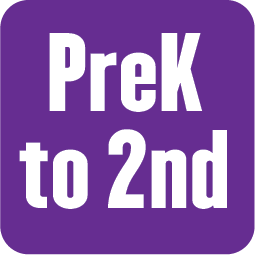
Grades Prek-2 art kit recommendations: #2 pencil, eraser, colored pencils, glue, scissor, hand sharpener, crayons, white drawing paper, colored paper
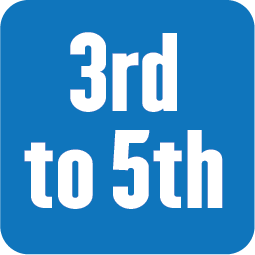
Grades 3-5 art kit recommendations: #2 pencil, eraser, colored pencils, crayons, glue, scissor, hand sharpener, oil pastels, watercolors, paintbrushes, markers, sketchbook, colored paper

Grades 6-8 art kit recommendations: basic drawing pencil set, eraser, colored pencils, glue, scissor, hand sharpener, tortillon/blending stump, crayons, oil pastels, watercolors, round watercolor brushes sizes 3, 6, 12, basic tempera paint set, tempera paintbrushes, markers, sketchbook, Sharpies, modeling clay, colored construction paper, 1:1 computer
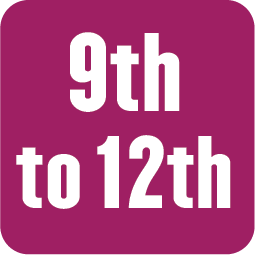
Grades 9-12 art kit recommendations: basic drawing pencil set, eraser, kneaded eraser, charcoal, colored pencils, glue, scissor, hand sharpener, tortillon/blending stump, crayons, oil pastels, watercolors, round watercolor brushes (sizes 3, 6, 12), basic acrylic set, acrylic paintbrushes, markers, sketchbook, Sharpies, modeling clay, colored paper, 1:1 computer
Technology Considerations
For hybrid, in-person and remote learning:
- Ensure a digital device and internet Wi-Fi access/hotspot access for all students and staff on a 1:1 basis. Students in the same family should have access to their own individual learning device. Seek assistance from companies to help families/parents to gain internet access in partnership with the district.
- Identify whether students have a digital camera or camera phone to capture images for upload and review in digital portfolios.
- Establish district approved video conferencing and technology tools to support learning and management of learning such as Google Classroom and Google Suite for Education, Screencastify, Flipgrid, Edpuzzle, and Bitmoji Classroom, among others. Discover how learning management systems such as Canvas can support live instruction, provide instructional resources, learning with model videos and multiple submission options.
- Consider Artsonia as the HUB for art instead of Google Classroom – Artsonia has really stepped up to make a new app that is much more powerful. It allows teachers to create and post their own demo videos. Then students can upload their own Gallery/Portfolio. Where teachers can then comment on the artwork – these comments are private to the student/parents/guardians only.
- Encourage regular use of Chromebooks in the art classroom where students can use google classroom for exit tickets, posting reflections, checks for understanding and quizzes, Flipgrids presenting their work or doing art analysis, etc.
- Use Chromebooks or other district supported electronic devices during in-person time in arts classrooms to train students in the use of digital drawing and painting tools using drawing apps available for Chromebook, etc., Students can continue to create digital artworks as an option in lieu of using traditional materials.
Professional Development
For in-person learning:
- Establish a parent/student academy for tech training and support.
- Provide PD to visual arts teachers in the use of technology tools to create digital artwork using hardware and software supported by school and district.
- Holistic training for staff members on protocols and procedures to maintain social distancing for students.
For hybrid, in-person and remote learning:
- Intensive training in CDC guidelines including ways to sterilize art supplies and materials if they need to be shared and time built into the school day for cleaning.
- PD on What does the “new reality” mean for schools? Protocols, procedures, supporting students during a pandemic, etc.
- Coordinated professional development for teachers to learn video conferencing platforms, Google Classrooms, Google Suite for Education, Screencastify, Flipgrid, Edpuzzle, Padlet, etc.
- Instructing arts teachers in the use of available tools and technology for video recording, editing, and how to upload for student viewing and teacher ability to teach to students in upper grades.
- Invest time for professional development on the new NJSLS for Visual and Performing Arts including the SEL competencies crosswalk with arts learning standards. Training can focus on understanding the standards, strategies to use within this environment, how we can shift teaching and learning, the social emotional aspect of teaching and learning during a pandemic (how are we supporting students/staff?).
- Schedule workshops and classes for parents and students to experience online learning platforms for themselves. It makes it a lot easier for them to support their children if they are familiar with the platforms in use by the district/school.
- Establish time and structures for PLCs (professional learning communities) with arts teachers to share and collaborate on best practices for student achievement.
- Create opportunities for online resources such as the Art of Ed to provide professional development targeting specific needs to support student learners and improve teaching practice for student outcomes. This can be used for targeted PLCs such as “engaging students in the critique process” training for a team of teachers to implement during in-person, hybrid or remote learning.
- Generate a list of digital tools, apps, and websites with a quick description of what the resources do and how to use them. For example, “Instagram allows people to share photos, others can comment on these photos.
Additional Resources and Citations
Featured Webinar on Demand – September Ready: Seven Principles for Planning & Preparation
https://artsednow2020.com/nj-arts-ed-summit-2020/ Recordings from the ArtsEdNow 2020 Summit June 16-18th. – Lessons Learned and Looking Forward: School Years 2020–2021 and 2021–2022
NAEA Town Hall Conversations | April 20, 2021
www.SELARTS.org Social and Emotional Learning
https://njartsstandards.org/ NEW NJ Visual Arts Standards
https://www.arteducators.org/learn-tools/remote-learning-toolkit NAEA Remote Learning Toolkit
Sample lessons using basic supplies
Grades 6-8 lesson on Understand the Life and Art of Henri Matisse
Grades 6-8 lesson on Textures
Grades 6-12 lesson on Line Value Techniques for Shading
Grades 6-12 lesson on Digital Darkroom slides
Grades 9-12 lesson on Art After Tragedy
Museums
https://www.newarkmuseumart.org/
https://www.state.nj.us/state/museum/
https://artmuseum.princeton.edu/
http://www.zimmerlimuseum.rutgers.edu/information/visitors#.Xv95ZihKjIU
https://www.groundsforsculpture.org/
SMART History (Art history Resources)
MOMA Teacher Resources
Guggenheim online
Metropolitan Museum of Art Resources Online for Educators
Philadelphia Museum of Art Educator Resources
https://www.nga.gov/ – National Gallery of Art
https://nmaahc.si.edu/ – National Museum of African American History & Culture
The 75 Best Virtual Museum Tours Around the World [Art, History, Science, and Technology]
Getty.edu
Museivaticani.va
Nhm.ac.uk
Nationalgallery.org.uk
Google Arts & Culture App
Stuck at Home? These 12 Famous Museums Offer Virtual Tours You Can Take on Your Couch (Video)
https://upgradedpoints.com/best-virtual-museum-tours/ – 75 Best Virtual Museum Tours Around the World [Art, History, Science, and Technology]
Arts Education
(NEW) PBS Learning Media
(NEW) Nasco lesson plans
(NEW) Artsonia Project ideas
(NEW) NAEA Looking Forward
PBS KQED Art School
Take home 40 Art Challenges– Download this handout of 40 art challenges
Amber Kane; How to teach art online
K-12 Free Downloadable Art Learning Packets
https://www.artedguru.com/ – Covid19 Remote Teaching Resources
Jules White- Distance Learning
GRID OF ART SITES: Ready to stay creative from the couch? Here is your guide to enjoying art at home! (courtesy of our friends at MAEA)
https://myartlesson.com/free-resources-for-art-teachers/
http://discoveryk12.com/dk12/how-it-works/ – Discovery K12 provides a complete onlinecurriculum for Pre-K to 12th grade. All main subjects are covered, plus extra-curriculum courses.
Paula Mclain– Lessons and ideas she compiled from other art teachers, institutions, etc.
Art Prof is a free website for learning visual arts.
https://theartofeducation.edu/
Technology
How to Make Stop Motion Video: Ideas for iPad Movie Projects
Carol Bowen YouTube Videos of her flipped classroom
https://www.artedguru.com/copyright-statement.html
https://adaptablelearning.teachable.com/courses
https://www.novakeducation.com/iitb
www.PhotoPea.com – a web-based knockoff of Photoshop that is very, VERY close to it.
www.Canva.com -a great resource to teach kids design. They have free educational access for teachers.
https://www.gimp.org/ -Free and Open source Image Editor
Social Emotional Learning (SEL)
(NEW) Effective SEL Activities
(NEW) Nasco Art & SEL
(NEW) Art of Education Elementary School and SEL
www.SELARTS.org
Developing Curricula for SEL and the Arts
Arts Education and Social-Emotional Learning Outcomes Among K-12 Students
Social-Emotional Artistic Learning
Culturally Responsive Education
NYS ED.gov Culturally Responsive-Sustaining Education Framework http://www.nysed.gov/common/nysed/files/programs/crs/culturally-responsive-sustaining-education-framework.pdf
Seven Core Themes of the Culturally Responsive Arts Education Initiative https://www.heinz.org/userfiles/file/crae_corethemesfinal.pdf
The Education Alliance Brown University Culturally Responsive Teaching | Teaching Diverse Learners
Social Justice
Resources for Teaching Civil Unrest and Anti-Racism
Google Arts & Culture App
A best-of-the-best collection of resources for social justice- and equity-focused educators – Talking to Kids About Racism and Justice: a list for parents, caregivers & educators
15 Art Projects that Advocate for Social Justicehttps://www.artsednj.org/featured-webinar-september-ready-seven-principles-for-planning-and-preparation/
July 2020 Fall 2020 GuidanceDo you have additional info to share? Help us enhance and keep this resource relevant here:

As of the September 2022 update of this guidance, THERE ARE NO STATE MANDATED COVID MITIGATION REQUIREMENTS and Visual and Performing Arts Programs are returning to pre-COVID pandemic practices. Each district is making individualized determinations in response to CDC and/or New Jersey Department of Health recommendations and the needs of its community.
NJ's Arts and Culture Partners are Back in Schools!
The impact of the pandemic had a deep and lasting effect on young people’s lives. Arts education has always helped students connect to their creativity, sense of identity, and expression of their voice. In this ever-changing time of recovery and expansion after COVID, arts education is more critical than ever. Arts education helps students reconnect to the power of joyful learning, and provides the social emotional learning students need.
New Jersey’s Arts and Culture Partners are safely back in schools, bringing professional artists to classrooms and auditoriums across the state. Professional teaching artists and performing artists have a powerful role to play in schools. Artists’ creative practice and skill are energizing, motivating and encouraging to adults and students in schools. Offering artistic disciplines, cultures, perspectives and art forms not available in a typical school setting, arts and culture partners are a critical learning resource, especially in these challenging times.
New Jersey’s Arts and Culture Partners have made the following commitments to maintain safety while engaging students and school communities in performances, workshops, long term residencies, and family programming.
Vaccinations
- Vaccination: Arts and Culture Partners will require artists to be vaccinated to do in-person work in schools. Upon arrival at school, artist(s) will provide proof of vaccination. If a teaching artist is unable to be vaccinated, they will provide a negative test within 72 hours of visit to school.
Mitigation Protocols
- Physical Distancing: Teaching artists or performers will maintain 6 feet apart from students, when possible. Close contact will be limited.
- Space/Location: Arts and Culture Partners will discuss classroom or performance space to be used ahead of time, and will attempt to use outdoor spaces as much as possible.
- Materials & Cleaning: artists will limit sharing of materials, sanitize materials between uses, and/or create art “kits” for each student.
- Masks: Should masks be required by the school partner or the Arts and Culture Partner, the organization’s staff will communicate and work collaboratively with school partners.
Scheduling & Program Format
- Flexible Scheduling: Arts and Culture Partners offer flexibility with scheduling and rescheduling, due to Covid 19, without any cancellation fees.
- Flexible Formats: If a school requires a change in format, Arts and Culture Partners will offer hybrid or virtual programming to replace in-person programming when possible.
Prevention
- Self-Check: Artists will self-check for Covid symptoms daily. If Covid symptoms are present, artist(s) will reschedule that day’s visit to the school, disclose to the Arts and Culture Partner and school.
- Open Communications: There will be disclosure between the Arts and Culture partner, artist and school about known exposures, and transmission. If there is an exposure at the school or if the artist experiences a known exposure, a reschedule will be put in place to allow for quarantine time.
How will your Arts and Culture Partners Support Your Students and School Community? The Power of Partnerships
Your arts and culture partners have emerged strong and ready to embrace the needs of the return to in-person schooling, understanding that the journey ahead will require partnership, collaboration, creativity and vision, including the following commitments:
Students
First
Arts and cultural partners will prioritize the needs of students in program planning and implementation.
SEL and Cultural Responsiveness
The impact of the pandemic and the uprising against racism necessitate significant support for educators and students. Arts and cultural partners have prioritized Social Emotional Learning (SEL) and Culturally Responsive practices. Arts and cultural partners support collaborative classroom environments where all students feel a spirit of belonging and can emotionally, intellectually and creatively thrive.
NJ State Learning Standards
Planning and programming will include state learning standards to be addressed, inclusive of arts standards and other subject matter.
Adaptable and Flexible Programming for all School Environments
Arts and cultural partners will adapt program formats and work flexibly with school partners.
Health & Safety
Arts and culture partners will adhere to school requirements for PPE, social distancing, and any other modifications for in-building programs.
Technology
Advance information on technology platforms used in-school and for remote learning is needed for partners to prepare. Partners are adept in school platforms and online interactive tools.
Collaborative Program Development and Implementation
Teacher/educator involvement is required for all learning activities provided by partners. Collaborative pre-planning will include a discussion of desired interactivity, materials needed, space needs and other keys to sucess. Arts and culture partners will work collaboratively to ensure students can access the experience, using captioning, sign interpretation and other tools as needed.
Arts & Culture Partners
| Artistic Disciplines | Organization | 2021-2022 Program Offerings (Virtual, Hybrid, or In-Person) | Contact Information |
|---|---|---|---|
| Dance Media Arts Music Theatre Visual Art | Appel Farm Art and Music Center | Short- and long-term residency programs; professional learning for teachers | Kristina Hill khill@appelfarm.org |
| Dance Music Theatre Visual Art Media Arts | Artist in Education Residency Grant Program (AIE) | 20-day artist in residence programs | Samantha Clarke sclarke@yanjep.org |
| Dance Media Arts Music Theatre Visual Art | Arts and Education Center | New Jersey State Teen Arts Festival (www.njteenarts.com) Arts High (www.artsandedcenter.org) | Kevin Ciak kevin@artsandedcenter.org |
| Dance Music Theatre Visual Art Performances | Arts For Kids | In-person, virtual and hybrid in-school and afterschool Residency Programs and Professional development in music, drama, visual arts, dance, early childhood, and technology through the arts, as well as culturally diverse Arts-in-education live performances. (Pre-K to Grade 12) | Vincent Ector Executive Director Vincent@artsforkidsinc.org www.artsforkidsinc.org |
| Dance Music Theatre Visual Art Media Arts | Arts Professional Learning Initiative (APLI) | Cohort model professional learning program for teaching artists, art educators and classroom teachers | Samantha Clarke sclarke@yanjep.org |
| Dance Music Theatre | Axelrod Performing Arts Center | The Axelrod Performing Arts Academy offers Virtual and in-person artist residences with Broadway performers and professional dancers teaching Dance and Musical Theater, six days per week, for young people 12 and up plus a primary track for children 5-11. | Andrew DePrisco, Artistic Director adeprisco@ axelrodartscenter.org www.axelrodartscenter.org |
| Theatre Field Trips | Centenary Stage Company | Live performance Hands-on workshops (materials provided) Family and community building programs | Kayla Chirip, Director of Development kchirip@centenarystageco.org |
| Visual Art | coLAB Arts | Professional Development for teachers and short and long-term artist residencies connecting social justice and advocacy themes with artist response process. https://colab-arts.org/virtualeducation | John Keller, Director of Education jpkeller@colab-arts.org www.colab-arts.org |
| Dance Music Theatre Visual Art Field Trips | Count Basie Center for the Arts | Virtual and in-person options for school shows. Short and long-term residencies after school programs, and/or family & community programs either in-person or virtually, inclusive or all artistic disciplines: in theatre, dance, visual art, music. | Samantha Giustiniani sgiustiniani@thebasie.org |
| Visual Art | Frontline Arts | Virtual paper making workshops. In a series of sessions, we will walk your group through making handmade paper from start to finish with an assortment of pulp types. We also demonstrate printmaking techniques. | Rachel Heberling, Executive Director rachel@frontlinearts.org https://www.frontlinearts.org/frontlinepaper-foryouth |
| Theatre | George Street Playhouse | GSP offers Professional Development for teachers, K-12 artist-in-residence programs for students, theatre classes for youth and adults, and touring theatre programs for schools. Anchored in SEL and theatre arts integration practices, school-based programs build creativity, collaboration and academic achievement in ELA, Social Studies and Science content areas. | Jim Jack jjack@georgestreetplayhouse.org |
| Visual Art | GlassRoots | Virtual and in-person options for all glass art programming; short and long-term residencies; youth entrepreneurial afterschool programs; adult workforce programs; private group workshops; public classes and professional development for educators. | Lisa Duggan, Program Director lduggan@glassroots.org www.glassroots.org |
| Visual Art | Long Beach Island Foundation of the Arts & Sciences | Professional Learning Opportunities for Teachers Live Performance Hands-on workshops (materials provided) Student Competition After-school Youth Programming | Daniella Kerner, Executive Director dkerner@lbifoundation.org www.lbifoundation.org |
| Media Arts Music Theatre Visual Art Field Trips | Luna Stage | Luna Stage offers classes for K-12th grade students and adults in acting, improvisation, playwriting, filmmaking, musical theatre and more, all taught by theatre professionals. Scholarships are available, many classes culminate in a final sharing or performance, and all skill levels are welcome. Luna also offers student matinees of all MainStage performances. | Ari Laura Kreith, Artistic Director ari.laura.kreith@lunastage.org www.lunastage.org |
| Theatre | McCarter Theatre Center | McCarter Theatre offers in-person and online summer camps and after-school classes for K-12th grade students and adults, all taught by theatre professionals. Classes explore improvisation, monologue and scene writing, Shakespeare, dramaturgy, and creative movement. All skill levels are welcome, and scholarships are available. Many classes culminate in a final virtual sharing for invited guests. | Brooke Boertzel, Director of Education and Engagement bboertzel@mccarter.org https://www.mccarter.org/education-community/classes-and-camps/ |
| Visual Art Field Trips | Montclair Art Museum | Online, synchronous tours with art- making for schools and homeschooling/pods (supplies provided); online, synchronous multi-week studio classes (supplies provided); asynchronous educational materials; synchronous professional development workshops for teachers; family programs. Programs designed with diversity, equity, access, and inclusion in mind. | Noaa Stoler, Assistant Director, K-12 Learning and Gallery Interpretation nstoler@montclairartmuseum.org www.montclairartmuseum.org |
| Media Arts | Montclair Film | Virtual classes in filmmaking, screenwriting, podcasting, acting, storytelling and related arts education for middle and high school students, as well as Professional Development designed to enhance remote learning. Small hands-on classes taught by experienced professionals. | Sue Hollenberg, Education Director sue@montclairfilm.org www.Montclairfilm.org/Education |
| Dance Music Theatre Visual Arts | Morris Arts | Virtual artist in residence programs; virtual learning resources | Barbara Reuther breuther@morrisarts.org |
| Dance Music Theatre Media Arts Field Trips Performances | New Jersey Performing Arts Center | Virtual & In-person Saturday and weekday after school classes in Jazz, Band, Hip Hop, and Acting; virtual PD for educators; virtual SchoolTime performances and workshops; virtual live and pre-recorded video in-school residencies. | Vicky Revesz, Director, School and Community Programs vrevesz@njpac.org https://www.njpac.org/artseducation/ |
| Literary Art | New Jersey Poetry Out Loud | Poetry Out Loud, a free customizable poetry recitation curriculum that encourages students nationally in grades 9-12 to leverage poetry recitation as a dynamic tool for building social and emotional capacity. Not only do students share their interpretation and delivery of poetry; they also vie for awards and scholarships totaling $20,000. Additionally, New Jersey Poetry Out Loud offers a poetry community for teachers and students that’s provides professional development workshops, networking, and online experiences. Register Today! | Erik Stratton NJPOL Coordinator, admin@njpol.org www.njpol.org |
| Music Performances | New Jersey Symphony Orchestra | Virtual instrumental masterclasses and clinics; virtual PD for instrumental music educators (one on one and small group sessions on topics of their choice); access to digital library of enrichment and instructional videos and in person assembly programs | Judy Lee, Director of Operations & Community Programs, reach@njsympnony.org |
| Visual Art Field Trips | Newark Museum of Art | Virtual field trips (grades Pre-K-High School with grade-level specific content); virtual residencies in arts education and STEM. Professional development for teachers on various topics including mindfulness, diversity and inclusion and arts integration; virtual family programs focused on art making, storytelling, music, art and science. Creative Play for children ages 3-5 years old. Summer Art in the Garden programs. | Sarah Schettig, Manager of School and Teacher Programs sschettig@newarkmuseumart.org https://www.newarkmuseumart.org/virtual-field-trips https://www.newarkmuseumart.org/nmoaathome |
| Dance Folk Arts Music Theatre Visual Arts | Perkins Center for the Arts | Virtual and onsite classes/ lessons in pottery, drawing & painting, music, dance and after school arts exploration for K-12 students. Virtual Arts Residencies and professional development designed to support remote learning, SEL, DEI, STEAM, and Arts Integration through storytelling, as well as folk, environmental, visual, and performing arts. The Folklife Center at Perkins Center is host to the Homebound Arts in Healing Program, the Upon Our Authority virtual exhibition, The Butterfly Virtual Storytelling Concert Series, and a monthly podcast series.” | Allison Hunt, Director of Education ahunt@perkinscenter.org www.perkinsarts.org |
| Visual Art | Riverfront Renaissance Center for the Arts | Gallery tours, In-person and virtual exhibits, After-school and Weekend youth workshops (virtual & in person), Adult Art Workshops (virtual & in-person), Student Art Exhibits | Diane Roberts, Executive Director diane@rrcarts.com www.rrcarts.com |
| Dance Music Theatre | Rowan University Community Music School | Community Music lessons; Instrumental Ensembles, Theatre & Dance Academy, Professional Development for teachers; Engagement with University Faculty | Elizabeth Guerriero, Director of Community Music School & Educational Partnerships guerriero@rowan.edu go.rowan.edu/communitymusic |
| Dance | Roxey Ballet | Roxey Ballet is engaging our community and students in several ways: Through our virtual or in-person residency program; in person at our home theatre with education pods and learning programs; and through our live streamed and recorded performance events. Visit Roxey Ballet on Youtube for Videos and Enpointe interviews. https://www.youtube.com/user/roxeyballet | Lees Hummel, Director, Education and Outreach roxeyoutreach@gmail.com www.roxeyballet.org |
| Visual Art | Rutgers Camden Center for the Arts | Museum education at-home: online gallery tours & hands on kits, A New View Camden public art; livestream Stages of Discovery performances, Poetry Out Loud | Noreen Scott Garrity ngarrity@camden.rutgers.edu |
| Dance Theatre | Sharron Miller’s Academy for the Performing Arts | Short- and long-term in-school and afterschool residencies in dance and drama (in-person, virtual, or hybrid); lecture-demonstrations; professional development workshops; dance curriculum options include creative movement, tap, hip hop, cultural dance (e.g., West African, Latin), jazz dance, and theater dance among other styles | Sharron Miller, Artistic Director smiller@smapa.org www.smapa.org |
| Music Field Trips Performances | Symphony in C | In-person and virtual instrumental lessons, Music Together classes, assembly programs, school field trips, artist-in-residence programs, Youth Orchestra, and Summer Music Camp. | Pamela Brant President pbrant@symphonyinc.org |
| Media Arts Visual Art | The Center for Contemporary Art | In-person, virtual, and hybrid classes for children and adults in a broad range of media for all skill levels. In person classes for children with ASD and other special needs. Rotating on-site exhibitions of contemporary art. | Elie Porter Trubert, Executive Director etrubert@ccabedminster.org www.ccabedminster.org |
| Theatre Field Trips | The Growing Stage - The Children's Theatre of New Jersey. | In-person and virtual artist-in-residence programs, virtual after-school programs, virtual workshops, virtual field trips. | Lori Lawrence, Director of Educational Programming llawrence@growingstage. com www.growingstage.com |
| Dance Media Arts Music Theatre Visual Art | The Institute of Music for Children | Virtual and in-person group classes, private lesson and summer camp for children & teens in instrumental music, performing, visual and media arts. Grades 1-12. Financial Aid available. Arts residencies in many artforms for schools, community centers and more. | Alysia Souder Executive Director asouder@instituteofmusic.org www.instituteofmusic.org |
| Theatre Field Trips | The Shakespeare Theatre of New Jersey | Virtual and in-person workshops focused on language and performing Shakespeare's text; Virtual touring program (in-person touring/field trips may be available beginning in January); Student guide and workshop materials; Hybrid Shakespeare Book Club for teachers and adult-learners. | Brian Crowe, Director of Education bcrowe@shakespearenj.org www.shakespearenj.org |
| Dance Music Theatre | Trenton Circus Squad | Trenton Circus Squad is offering 40- 60 minute virtual circus workshops and performances for youth organizations in the fall. Trenton Circus Squad can provide circus bags full of circus goodies that each participant can use to practice at home or in a classroom setting. Included in each bag are (3) juggling scarves, sculpting balloons, balance stick, and a clown nose. | Thomas von Oehsen, Executive Director tom@trentoncircussquad.org www.trentoncircussquad.org |
| Folk Art Field Trips | Tuckerton Seaport | Tuckerton Seaport offers online and on-water programs currently. On-Water programs include small group (up to 10 passengers) boat tours aboard our floating classroom. While onboard, guests will experience Barnegat Bay coastal culture with a focus on folk arts. The Seaport is also building an online library of folk arts resource videos. These videos pair folk artists and demonstrators with activities families can enjoy right now from home. Floating Classroom Curriculum | Brooke Salvanto, Executive Director brookes@tuckertonseaport.org www.tuckertonseaport.org |
| Music | WBGO Newark Public Radio | WBGO's Education Hub Lesson plans for grades 3-12, based on Jazz Night in America documentary shorts, for teachers. Though designed for in-classroom teaching, the lessons can be modified for online instruction. | Brandy Wood, Marketing Manager bwood@wbgo.org https://www.wbgo.org/wbgo-education-hub |
| Dance Folk Art Music Theatre Visual Art Media Arts Performances | Young Audiences Arts for Learning New Jersey & Eastern PA | Assembly performances, artist in residence programs, workshops, professional learning for teachers and for teaching artists. Programming offered in person or virtual. | Donnajean Reckelhoff donnajr@yanjep.org Carol Hunt chunt@yanjep.org |
| Visual Art Field Trips | Zimmerli Art Museum | In-person and virtual field trips customized to grade level and curricular goals, educator guides, preschool art and storytelling programs, family and youth art-making programs, and professional learning to unlock the power of art for all | Amanda Potter apotter@zimmerli.rutgers. edu https://zimmerli.rutgers.edu |
Resources
The Arts Advantage: The Impact of Arts Education on Boston Students, study shows improved attendance and engagement in school when students are enrolled in arts coursework.
Theatre:
Teaching Theatre in the Era of COVID-19
Teaching Theatre Online: A shift in Pedagogy Amidst Coronavirus Outbreak
Educational Theatre Association
Scenario Planning Resources:
Envisioning the Future of Theater for Young Audiences
Shifts in the Low Touch Economy
Theaters for Young Audiences Say They Need to Be More Diverse
SEL & Culturally Responsive Teaching
When SEL Is Used as Another Form of Policing
Dreamkeepers, by Gloria Ladson Billings
Culturally Responsive Teaching and the Brain, Zaretta Hammond
Do you have additional info to share? Help us enhance and keep this resource relevant here:
General Resources
International Performing Arts Coalition Aerosol Study (NFHS)
US Department of Education Return to School Road Map
New Jersey Department of Education: The Road Forward Learning Acceleration Guide
PROTECT ARTS ED NOW/School Budget
Social Emotional Learning and Arts Education
The Center for Arts Education and Social Emotional Learning
Arts Education Social & Emotional Learning Framework
Collaborative for Academic, Social, and Emotional Learning (CASEL)
A Nation at Hope – Recommendations from the National Commission on Social, Emotional, and Academic Development
http://nationathope.org/report-from-the-nation/
Arts Education and Social-Emotional Learning Outcomes Among K-12 Students
Setting the Stage for Social Emotional Learning (SEL) Policy and the Arts
Scott N. Edgar and Maurice J. Elias
https://www.tandfonline.com/doi/abs/10.1080/10632913.2020.1777494
A Vision for Social Emotional Learning and Arts Education Policy
Scott Edgar and Bob Morrison
https://www.tandfonline.com/doi/full/10.1080/10632913.2020.1774830
SEL as a Lever for Equity
https://casel.org/lever-for-equity/
SEL Webinars:
SEL and Arts Education: Navigating Uncertain Times, Preparing for the Future
Maurice J. Elias, Scott N. Edgar, Bob Morrison
https://www.artsednj.org/fostering-social-emotional-learning-in-and-through-the-arts/
SEL and Arts Education: Elevating Student Voice and Community
Jennifer Tsukayama, Sheikia Purple Haze Norris, Justin Dominic
https://www.artsednj.org/fostering-social-emotional-learning-in-and-through-the-arts/
Music Education and Social Emotional Learning
https://nafme.org/advocacy/quarterly-advocacy-webinars/social-emotional-learning/
Advocating for Music Education Utilizing Social-Emotional Learning
Scott Edgar and Bob Morrison
The preparation of the September Forward 2021 Guidance for Arts Education involved the review of hundreds of documents for national and state organizations as well as research from around the world. All of the documents reviewed for the creation of this report may be found in this google drive link below. The files are organized as follows:
NJ State Guidance
- NJ State Guidance – Reports from various NJ based organizations
National Guidance
- Center for Disease Control Guidance – All relevant CDC Guidance
- National Federation of High School Associations Guidance for Music and Performing
- National Arts Education Reports – All released guidance from National Arts Education groups organized by discipline
- National Blueprints – Guidance from National Education Organizations
International Coalition of Performing Arts Aerosol Study
- NFHS and CBDNA with University of Colorado/University of Maryland
Other States Reports and Guidance
- State Reports – All available state reopening reports from across the nation
- State Arts Education Guidance – All available state level guidance for arts education from across the nation
Arts Ed NJ Support
- Advocacy Support – Tools and materials to support arts education supporters
- News Releases – For the New Jersey Student Learning Standards in the Arts and the new Arts Education & Social and Emotional Learning Framework
- Professional Development – New Jersey Professional Development for Arts Educators
- Social and Emotional Learning Resources
- Cultural Relevant Arts Education Resources
To stay up to date on the latest information sign up for the Arts Ed Now 2.0 app at:
Or go to:
September Ready Taskforce Members
Rose Acerra Dennis Argul Heather Barberi Lisa Conklin Richard Dammers Vincent Delucia Margaret El Michele Elefante Bari Erlichson Jeremy Grunin Porché Hardy Dawn Hiltner Priscilla Hopkins-Smith Lewis Kelly Rob Klimowski Wendy Liscow Carolyn Little Matthew Lorenzetti Cristina Marte Anthony Mazzocchi Danielle Miller Bob Morrison Patrick O’Keefe Daniel Paolucci Mary Reece Kira Rizzuto Michele Russo Jeff Santoro Dale Schmid Lisa Vartanian Elizabeth Zwierzynski | New Jersey PTA New Jersey Music Administrators Association Grunin Foundation Art Educators of New Jersey Rowan University New Jersey School Boards Association Art Administrators of New Jersey Elefante Music Arts Ed NJ Grunin Foundation New Jersey State Council on the Arts New Jersey Education Association Arts Ed NJ New Jersey Marching Band Directors Association New Jersey Thespians Geraldine R. Dodge Foundation New Jersey Thespians New Jersey Music Administrators Association Dance New Jersey Montclair State University Speech and Theatre Association of New Jersey Arts Ed NJ New Jersey Music Educators Association Speech and Theatre Association of New Jersey New Jersey Principals and Supervisors Arts Ed NJ Young Audiences of New Jersey and Eastern Pennsylvania New Jersey Music Educators Association New Jersey Department of Education New Jersey Music Educators Association Dance New Jersey |
Discipline Working Groups-Dance
Arvin Arjona Simone Baechle Laura De la Garza Noble Trista DeFilippis Emily Donahue Karen Love Cleo Mack Cristina Marte* Maribella Miller Kandice Point-Du-Jour Claudine Ranieri Megan Reagan Cassie Roberts Rossi Melissa Sande Marissa Stahl Gina Statile Nicole Zivkovic Elizabeth Rose Zwierzynski* | Milburn Public Schools Passaic Public Schools Rutgers University Hudson County Schools of Technology Cranford Public Schools Hillside Public Schools Middlesex County Vocational Technical School Dance New Jersey Franklin Township Public Schools South Orange-Maplewood Public Schools Paramus Public Schools Dance New Jersey Passaic County Technical Institute West Orange Public Schools Gloucester County Institute of Technology Garfield Public Schools Queen City Academy Charter School, Trenton Public Schools |
Discipline Working Groups-Music
Dennis Argul Katy Brodhead Cullen Amy Burns Laura Craig* Richard Dammers Nancy Dickinson Rebecca Dugan Mary Elder Arvan Gopal Libby Gopal Casey Goryeb Ron Heller* Sam Hitchell Cheryl Housten Lynnel Jenkins Jason Leshowitz Shawna Longo Matt Lorenzetti* Lewis Kelly Diana May Anthony Mazzocchi Kim Nimmo Patrick O’Keefe Jordan Peters Joe Ramalho Gabrielle Richa Duane Smith Bryan Stepneski Ashlen Udell Lisa Vartanian* Adam Warshafsky* Tom Weber | New Jersey Music Administrators Association Newark Board of Education Far Hills Country Day School in Far Hills Bridgewater-Raritan Regional School District Rowan University Washington Township Public Schools Paramus Public Schools Clifton Public School District East Brunswick Public Schools East Orange Public Schools Rockaway Township Public Schools Hopewell Valley Regional School District Bayonne Public Schools Montgomery Township School District Hopewell Valley Regional School District Clifton Public School District Hopatcong Borough Schools Linden Public Schools West Orange Public Schools Randolph Public Schools Montclair State University Paramus Public Schools New Jersey Music Educators Association Newark Board of Education Newark Board of Education Newark Board of Education Newark Board of Education Clifton Public School District Bridgewater-Raritan School District Paramus Public Schools Montgomery Township School District Westfield Public Schools |
Discipline Working Groups-Theatre
Felicia Brown Rob Klimowski Julianna Krawiecki Carolyn Little David Marconi Danielle Miller* Nicole Oliver Dan Paolucci* | Trenton Public Schools Burlington County Institute of Technology Princeton Public Schools Toms River Regional Schools Northern Valley Regional High School District Hoboken Public Schools Jersey City Public Schools Jersey City Public Schools |
Discipline Working Groups-Visual Arts
Lisa Conklin* Margaret El* Latasha Casterlow-Lalla Jennifer Khoury Andrea Lanchero Susan Bivona Aleksandra Drobik Whitney Ehnert Ellen Hargrove Debbie Cella Jennifer Johnson Danielle Dagounis Katrina Keeshan Kiera Spadaro Michael Fackelman Daniel Bertelli Monica Hill Diana Fernandez Veronica Barahona-Meza Frank Perrone Patricia Rowe Donna Minervini Kate Griffin Julie Keating Cat Gelchinsky Vincent Colabela Alexander Billups Nancy Lucas-Miller | Art Educators of NJ/Somerville Public Schools Art Administrators of NJ/Newark BOE Passaic Public Schools Bloomfield Public Schools Paramus Public Schools Bernards Township School District Bernards Township School District Montgomery Township School District Haddon Township Public Schools Glen Rock Public Schools New Providence School District School District of the Chathams School District of the Chathams School District of the Chathams Bernards Township School District Watchung Hills Regional High School Newark Board of Education Newark Board of Education Newark Board of Education Randolph Township Schools Moorestown Township Public School District Clifton Public School District Watchung Hills Regional High School Cresskill Public Schools Cresskill Public Schools Watchung Hills Regional High School Newark Board of Education Township of Union Public School District |
Discipline Working Groups Arts & Culture Partners
Pamela Brant Andrew Chiang Allison Davis Vincent Ector Silvia F. Fantoni Chiho Feindler Samantha Giustiniani Harrison Haney Porché Hardy* Kristina Hill Jim Jack Marshell Jones Kumahor Wendy Liscow Lauren Meehan Amanda Potter Michele Russo* Noreen Scott Garrity Alysia Souder Shirley Thomas Paul Whelihan | Symphony in C Nai Ni Chen Dance Company Arts Horizons Arts for Kids Newark Museum of Art VH1 Save the Music Count Basie Center for the Arts Arts & Education Center New Jersey State Council on the Arts Appel Farm Arts & Music Campus George Street New Jersey Symphony Orchestra Geraldine R. Dodge Foundation Arts Ed Newark Zimmerli Art Museum Young Audiences of NJ & Eastern PA Rutgers Camden Center for the Arts Institute of Music for Children Newark Museum of Art Pushcart Players |
